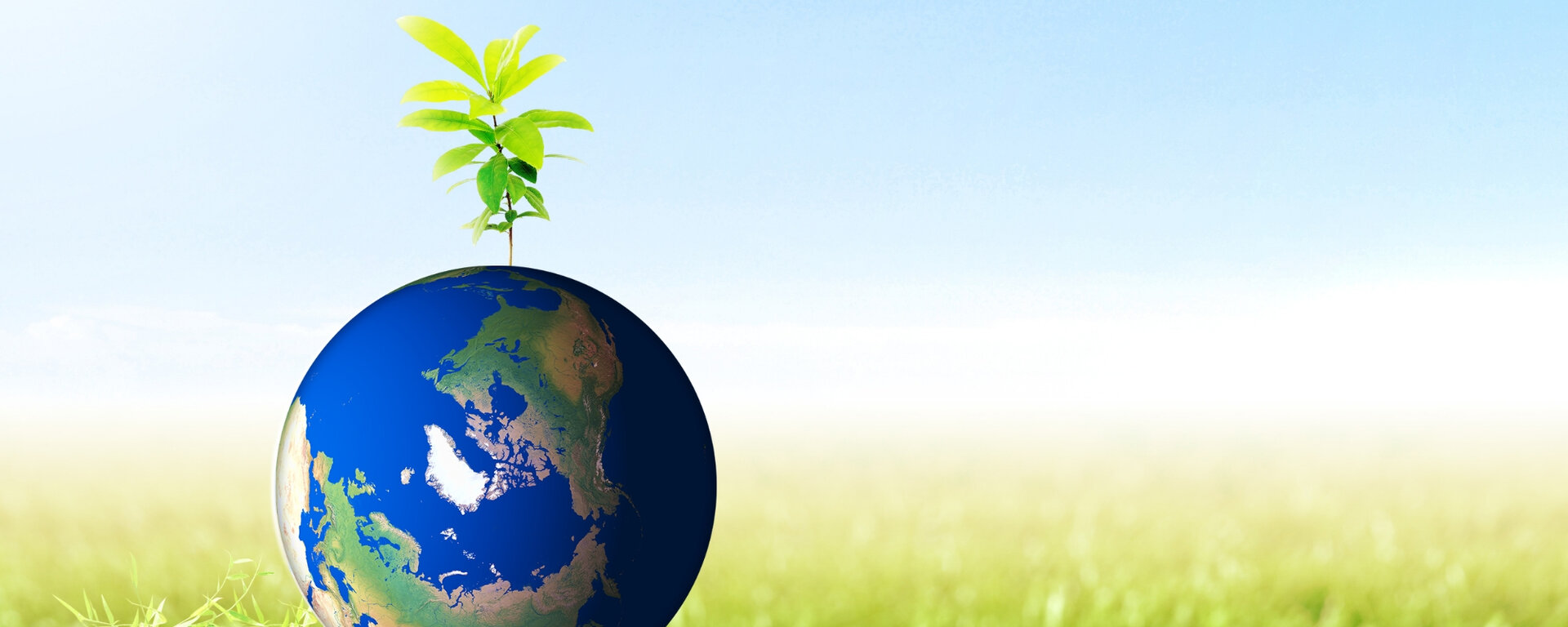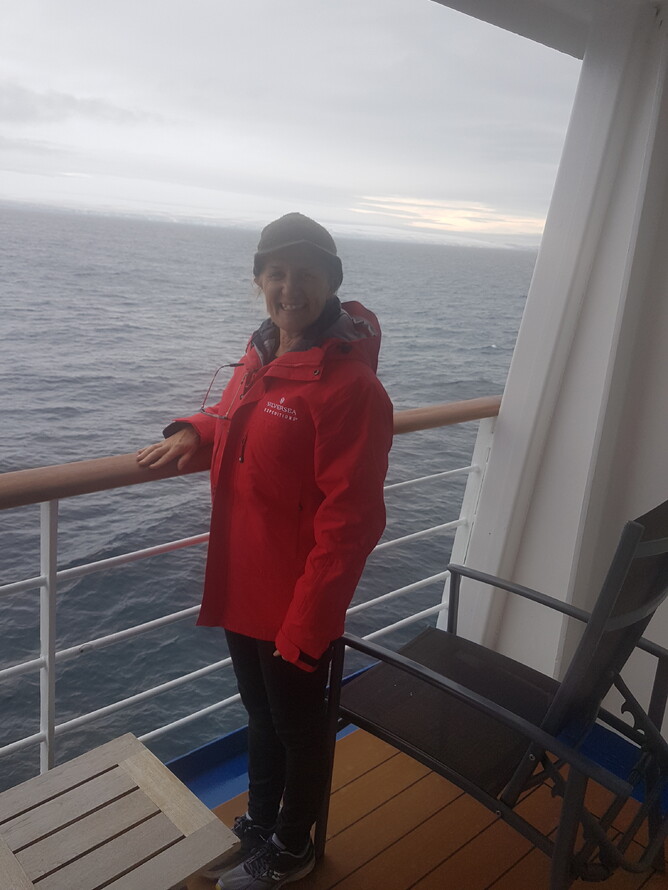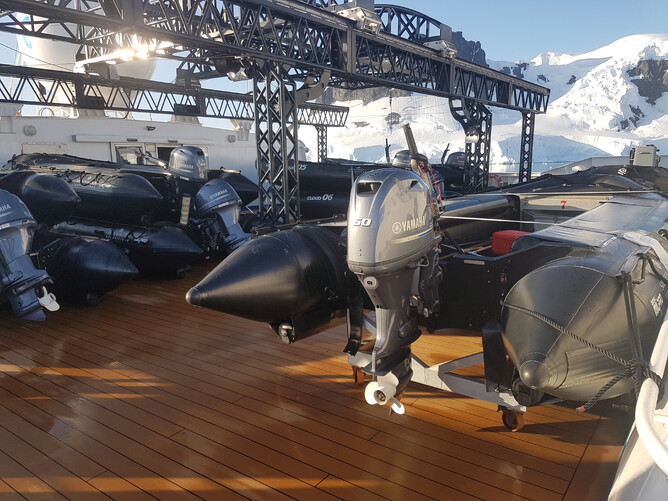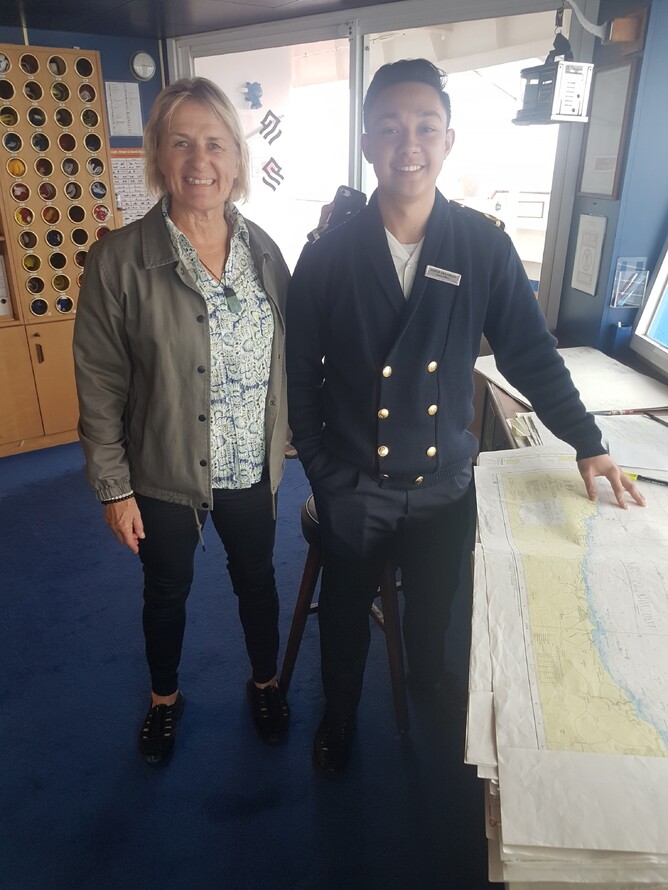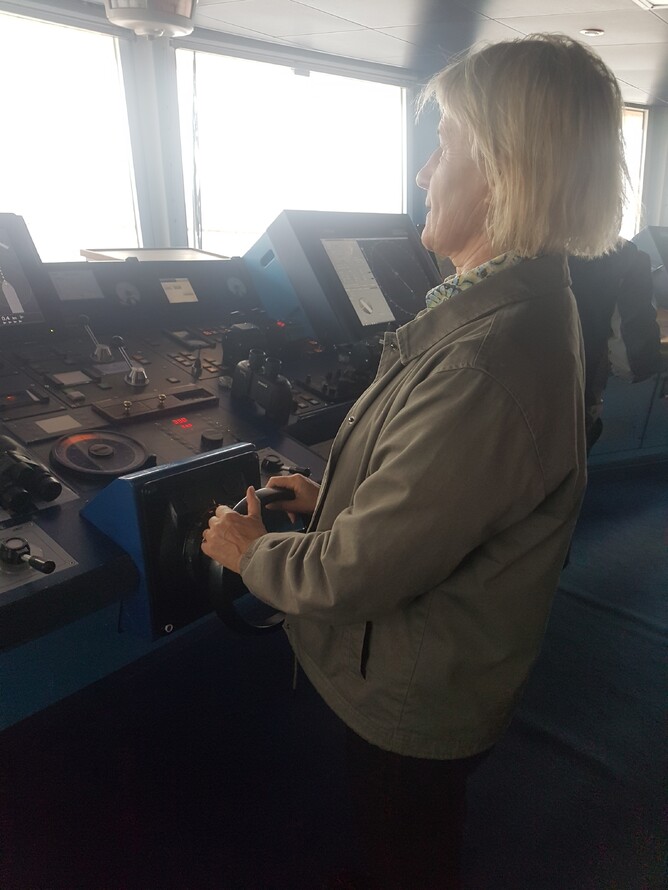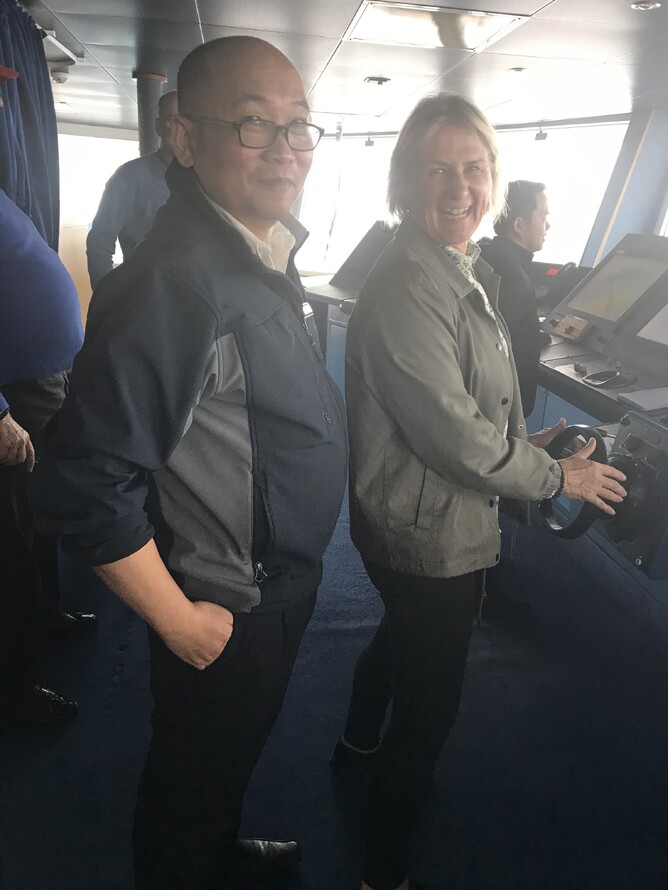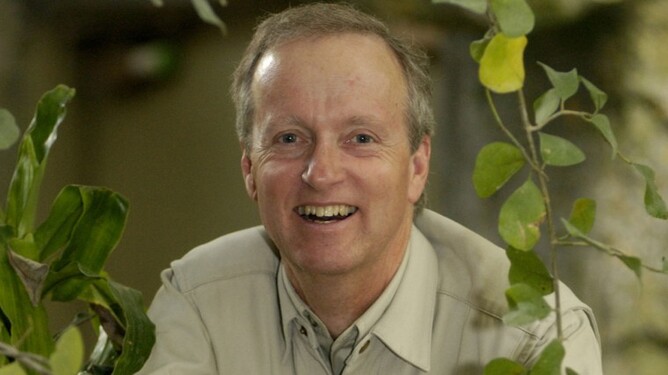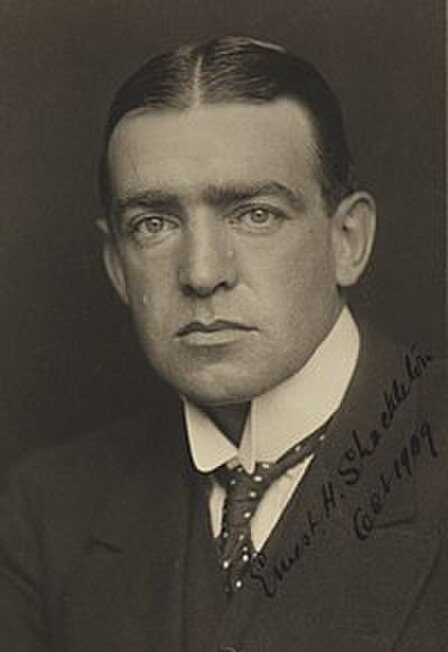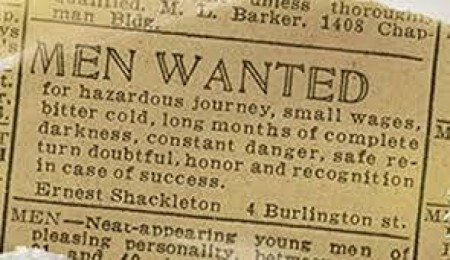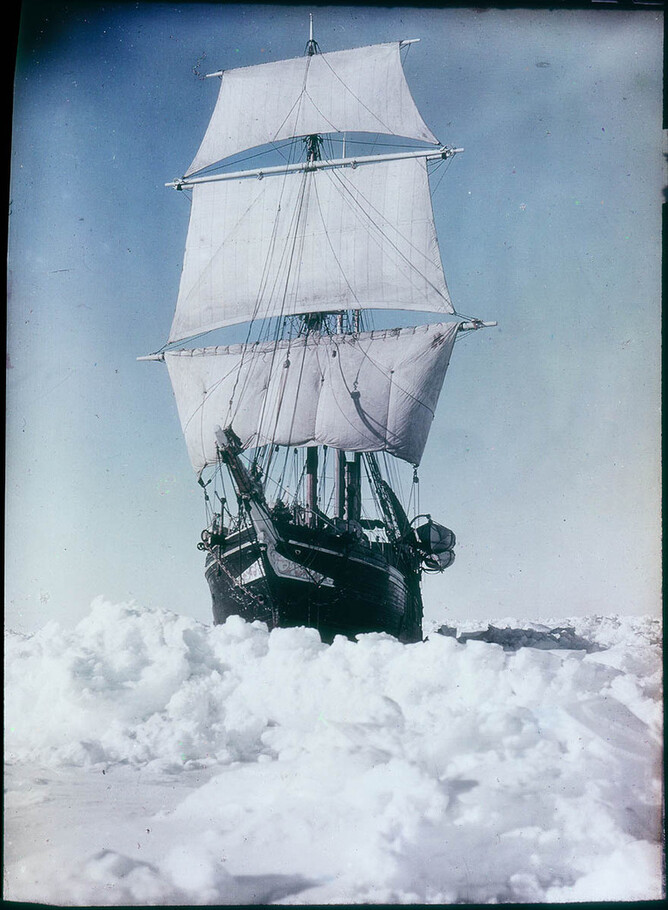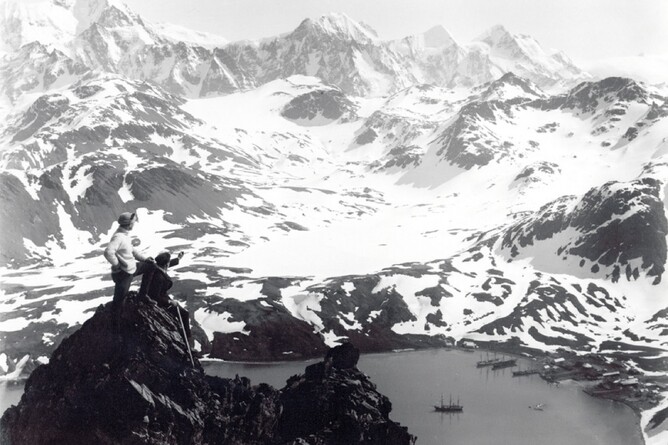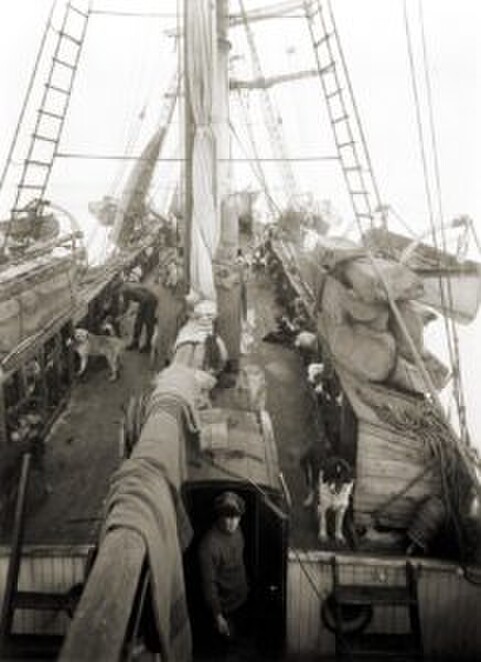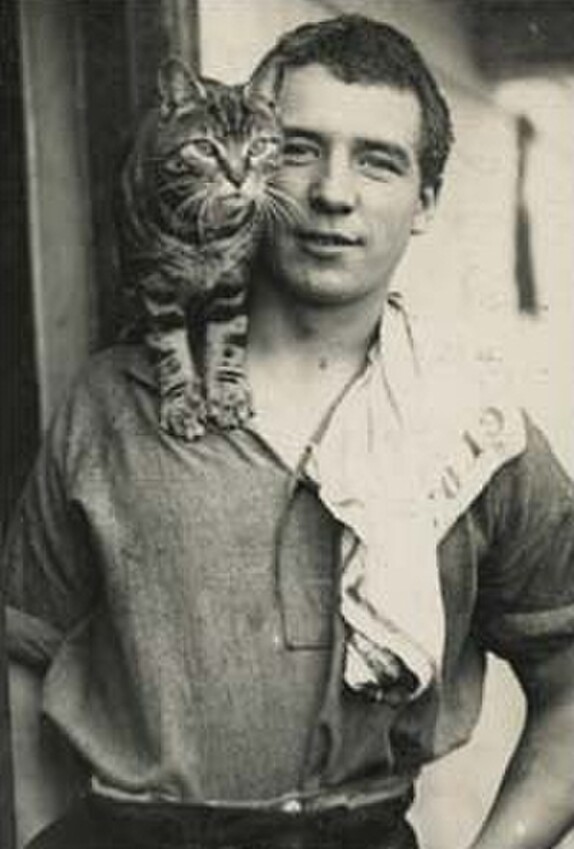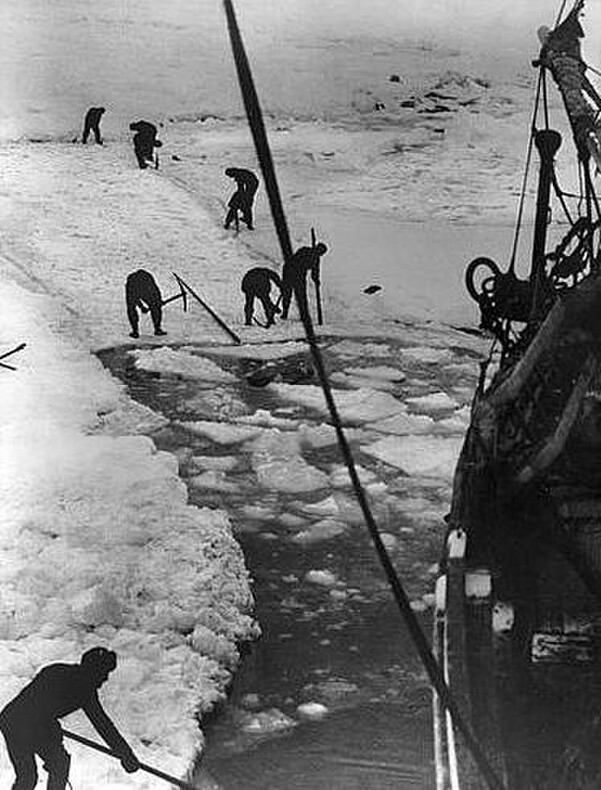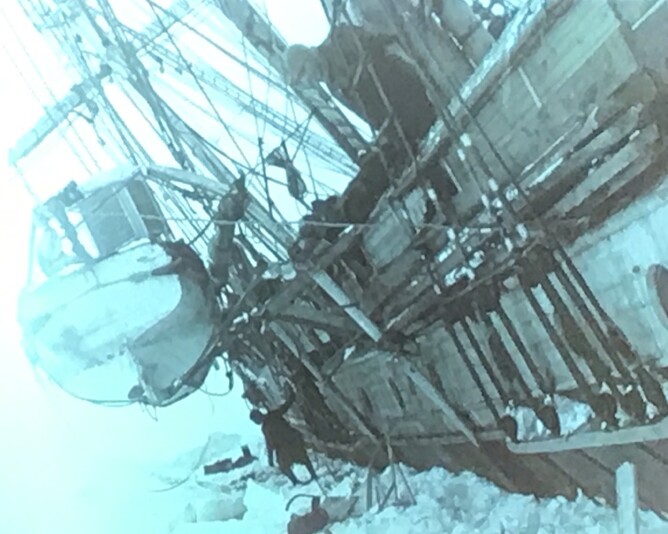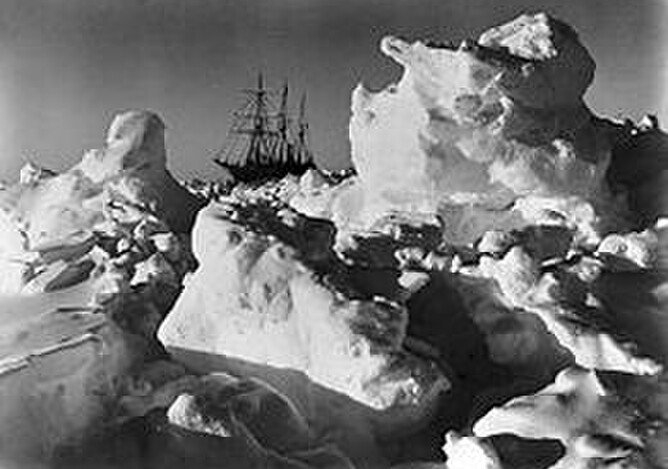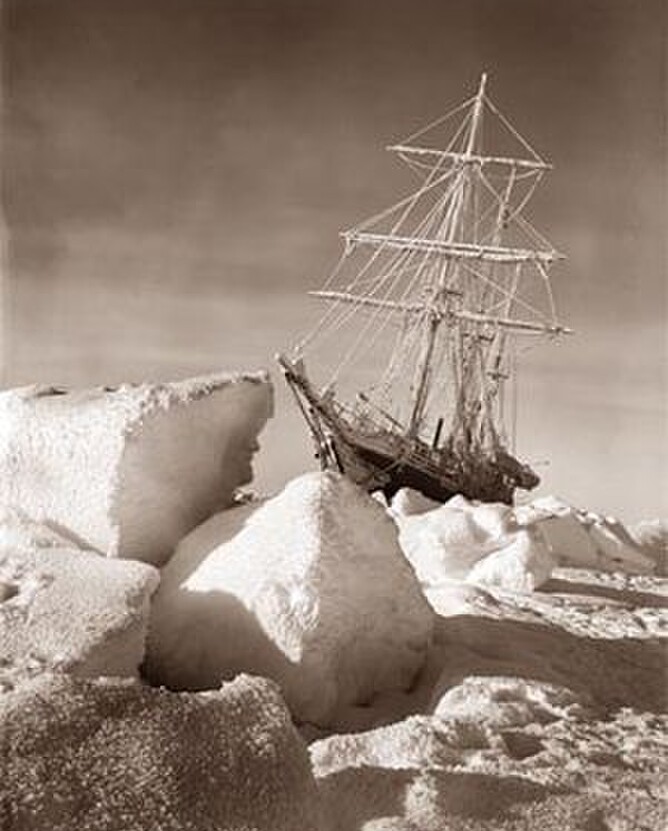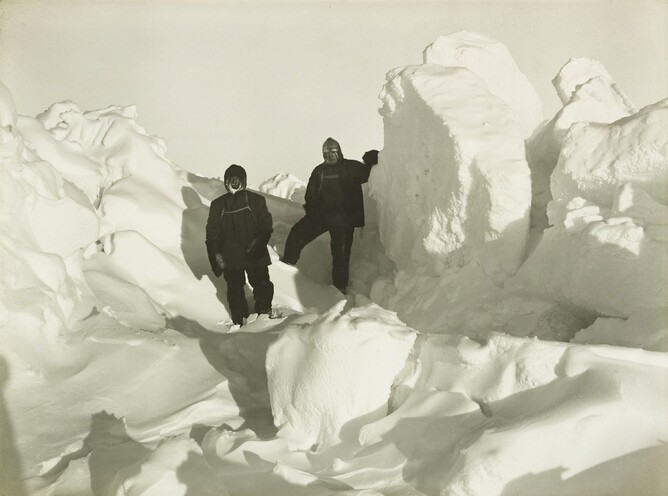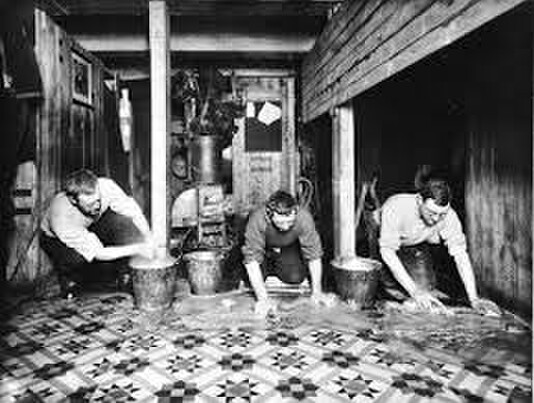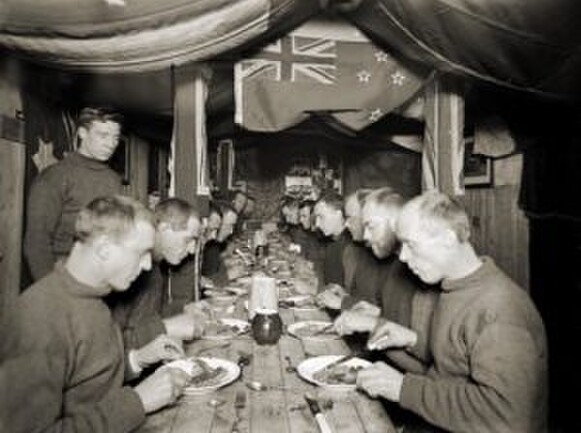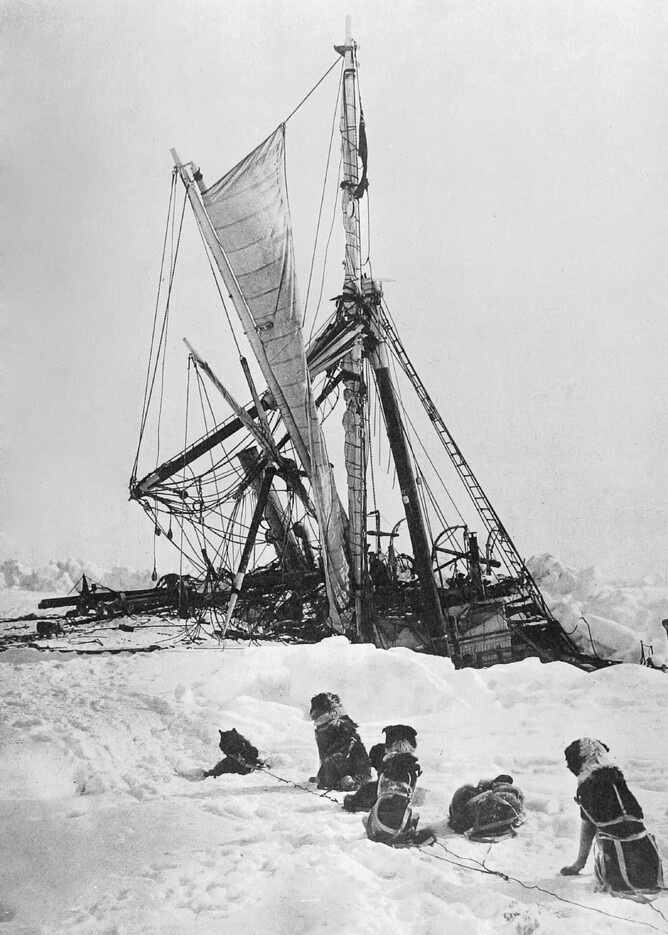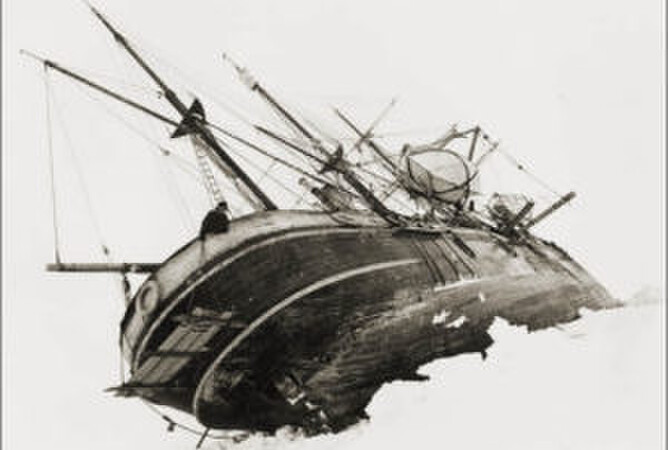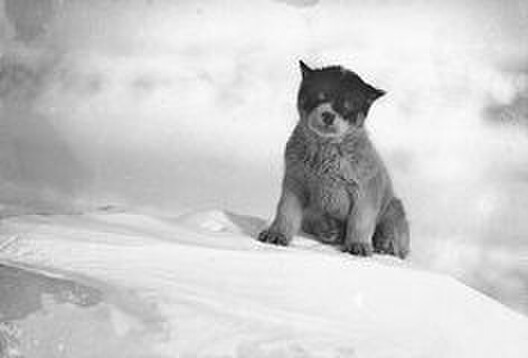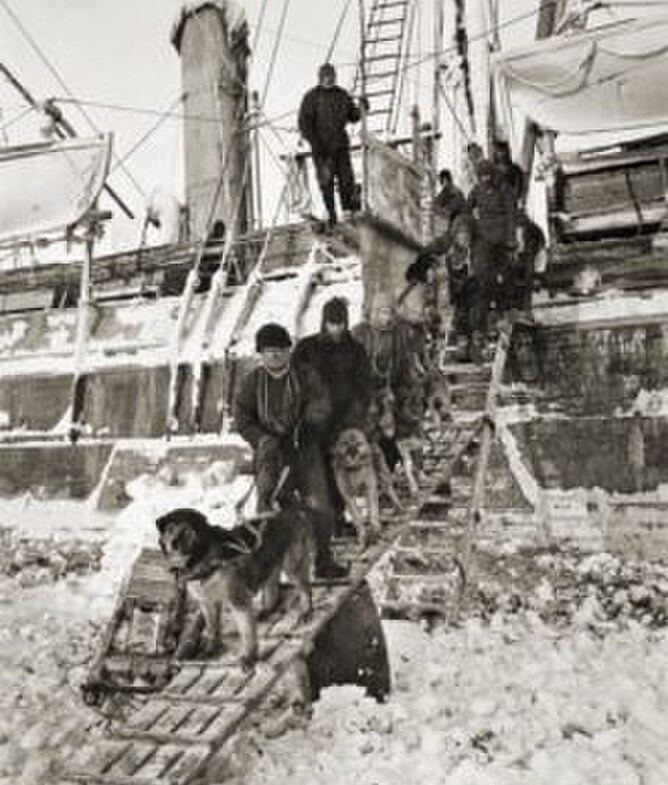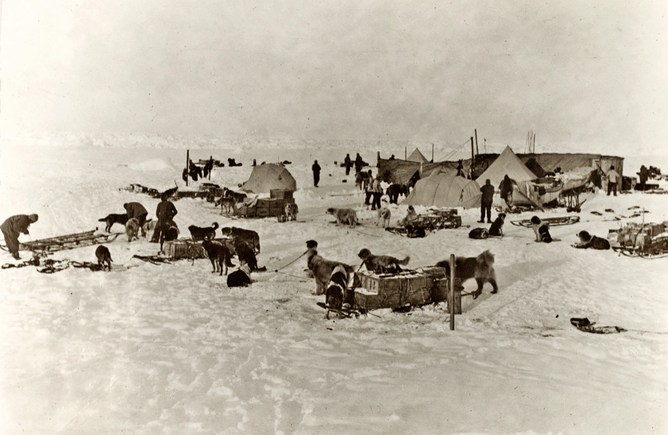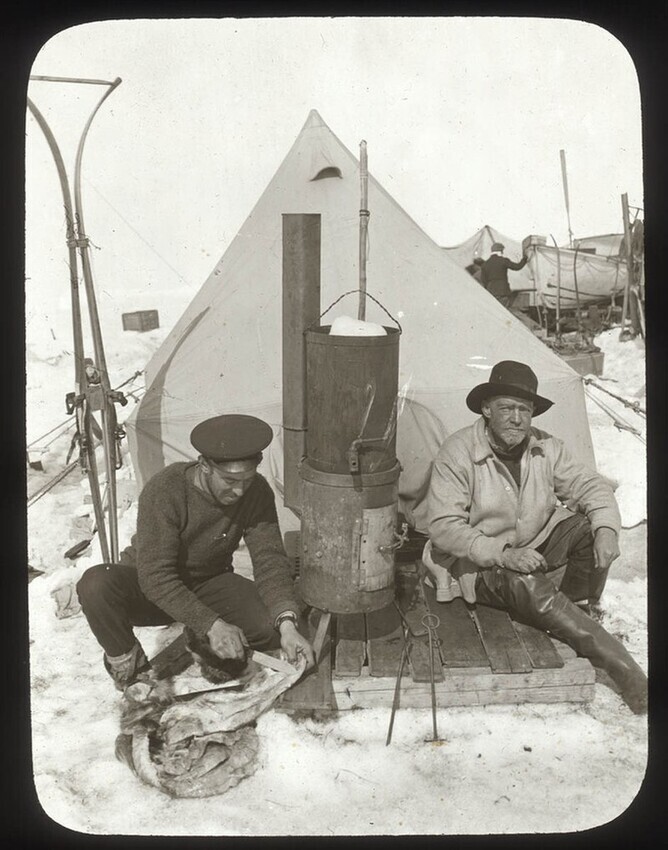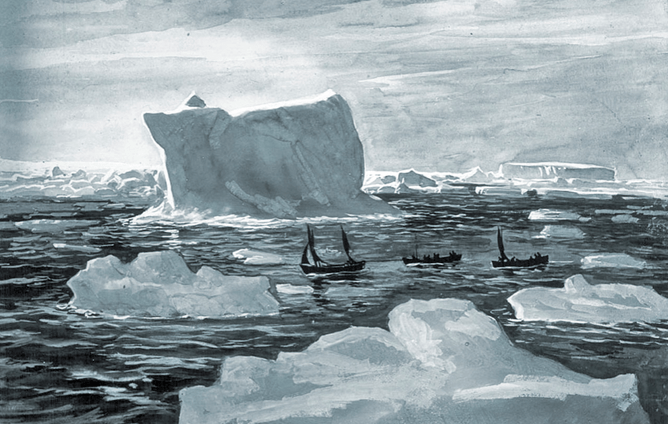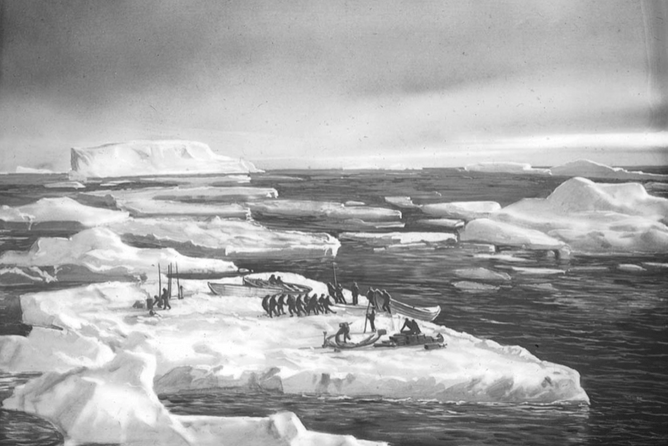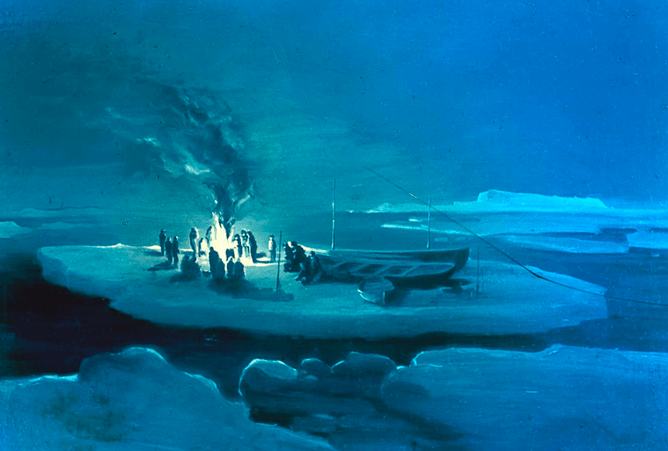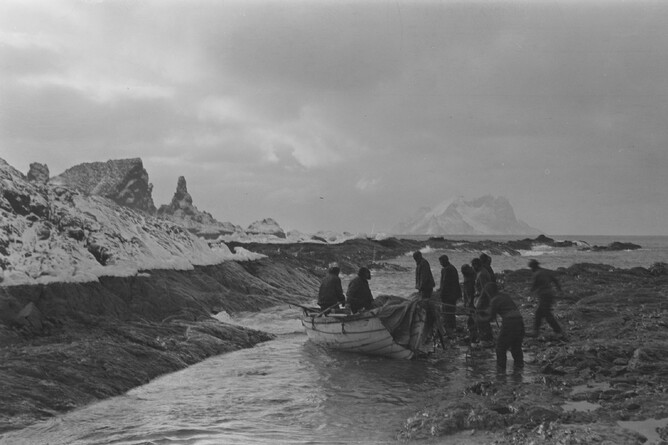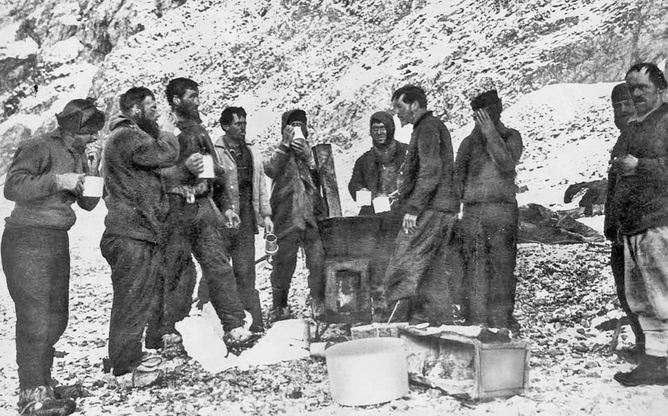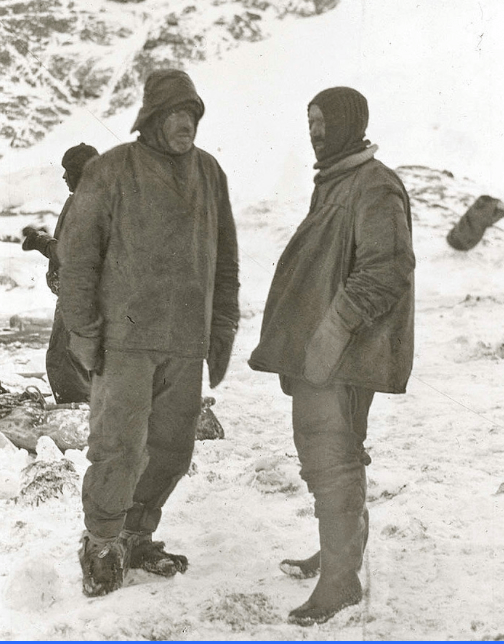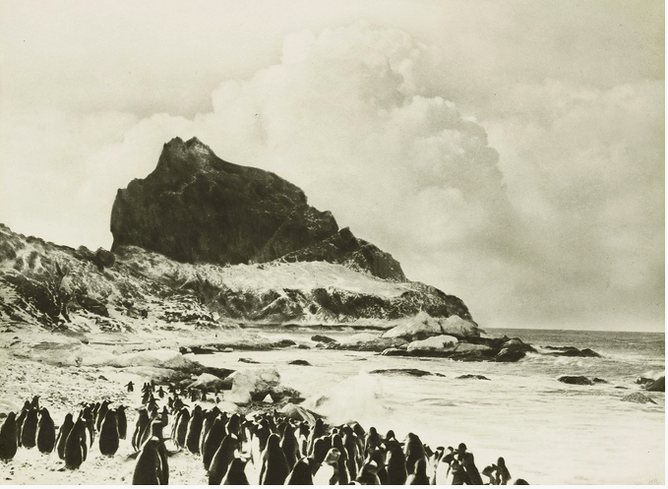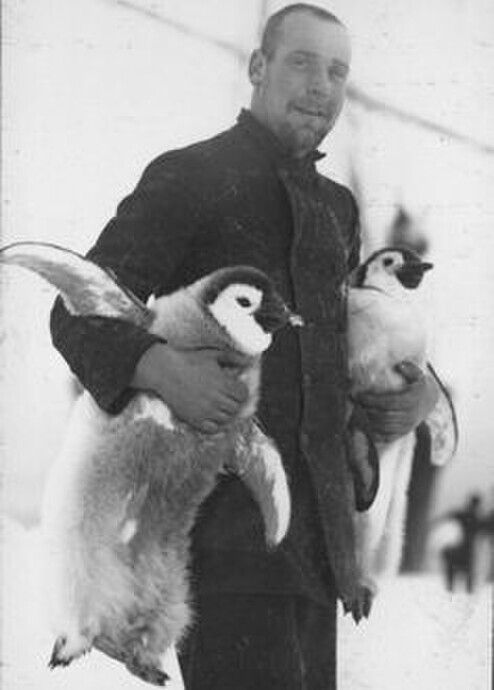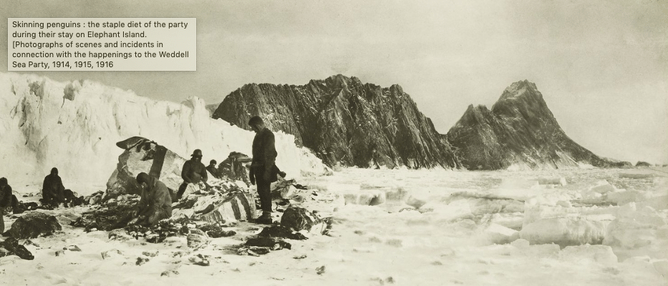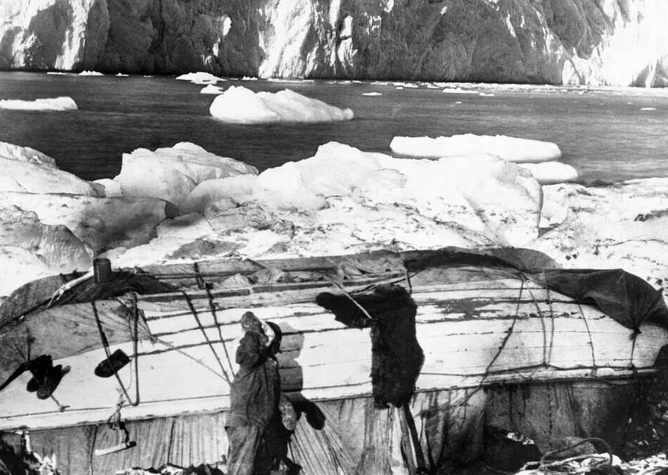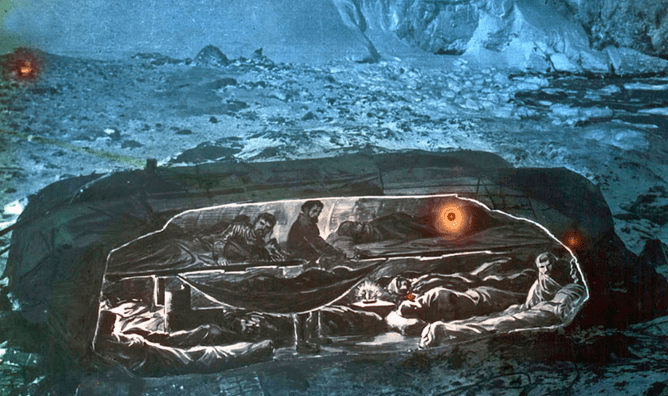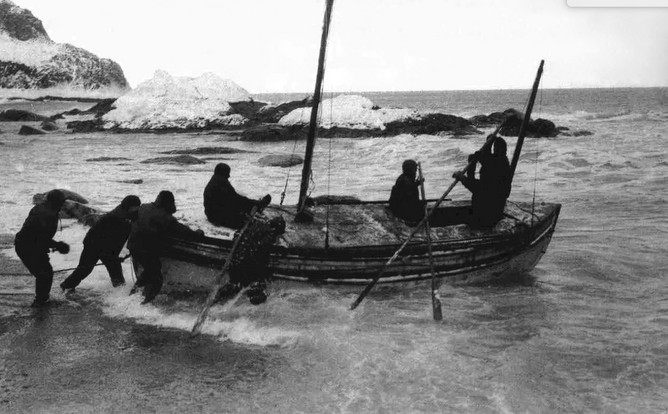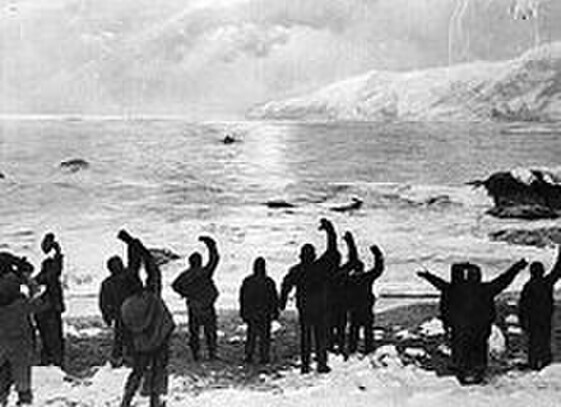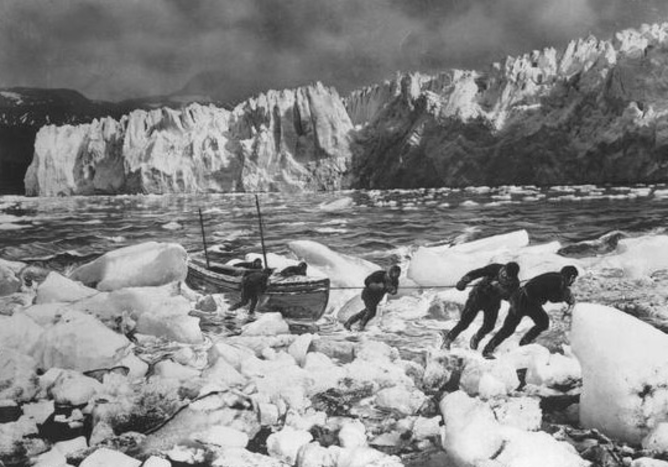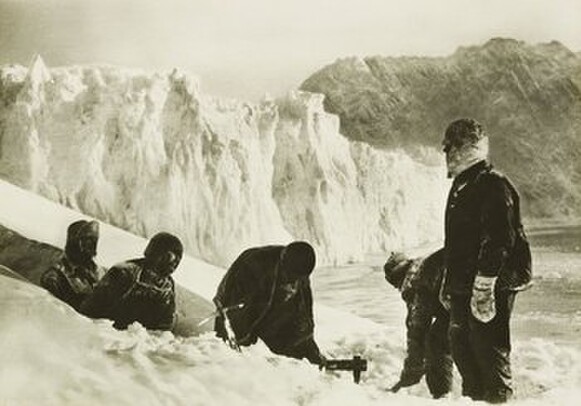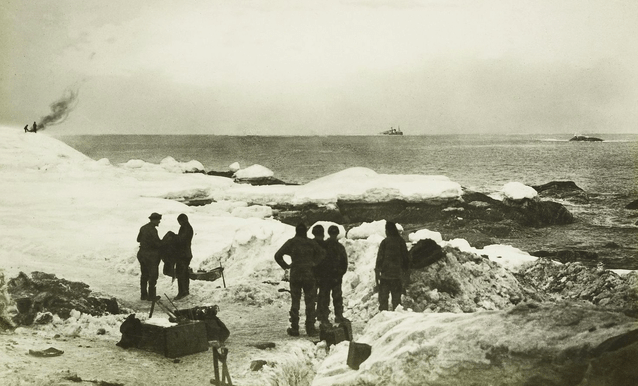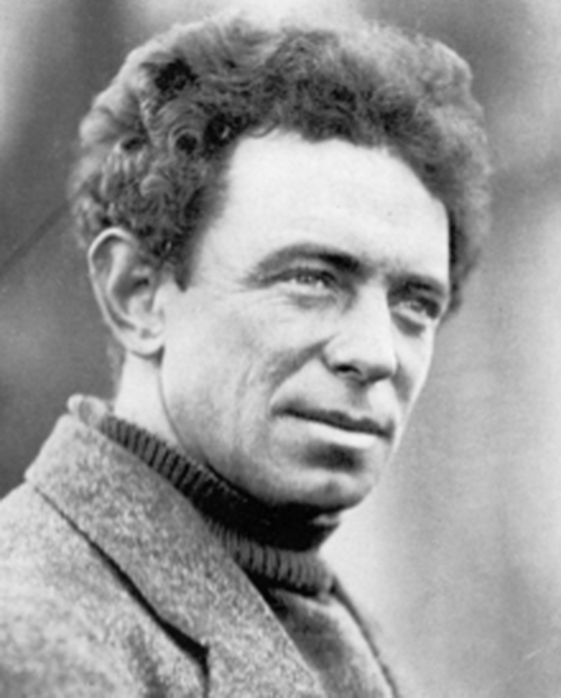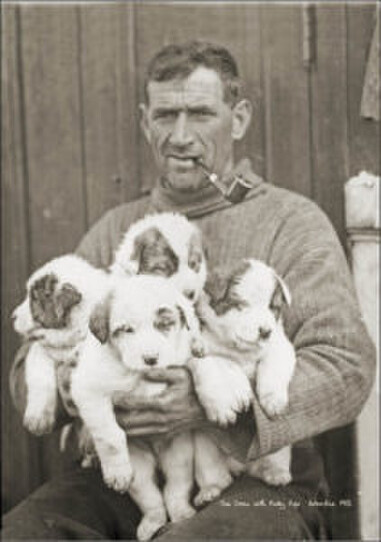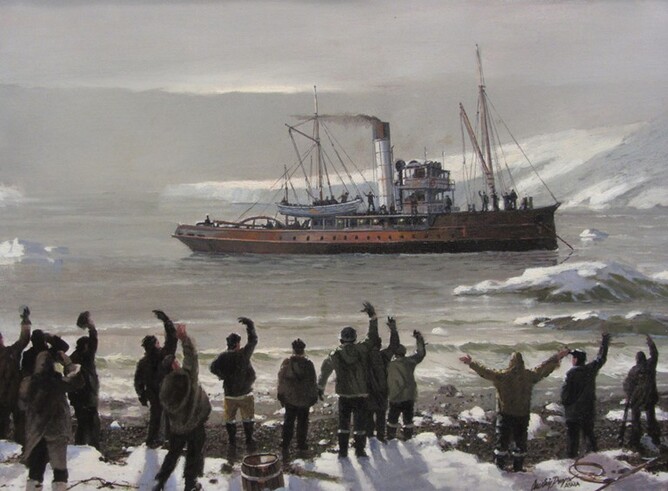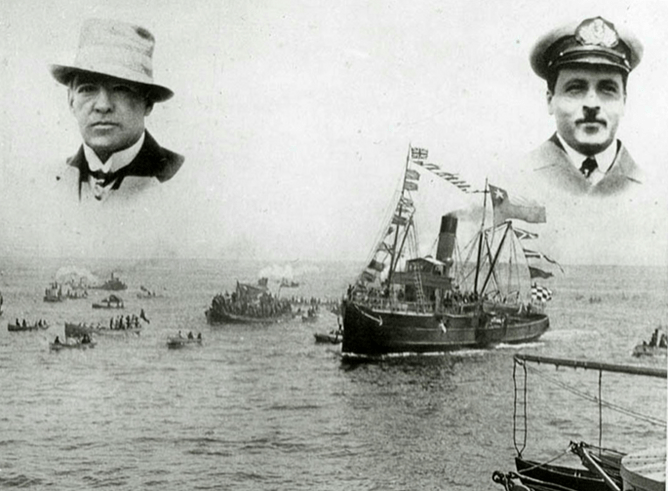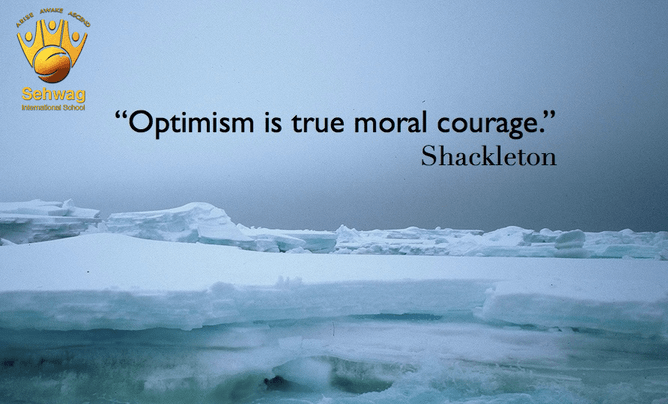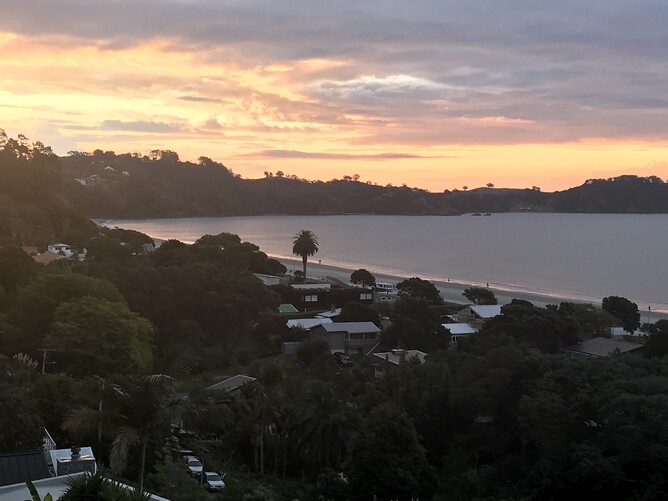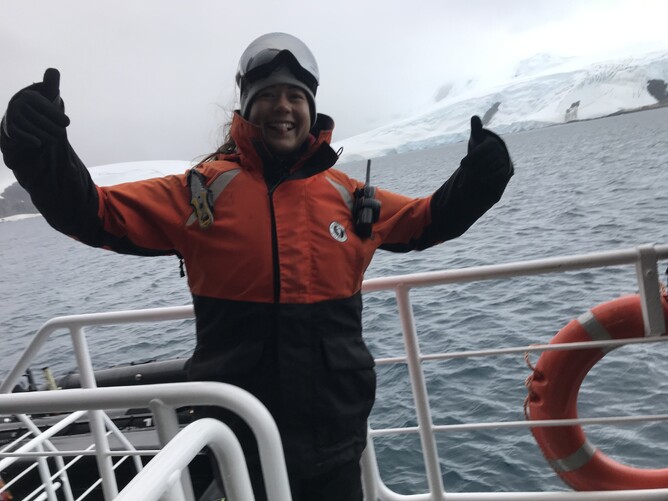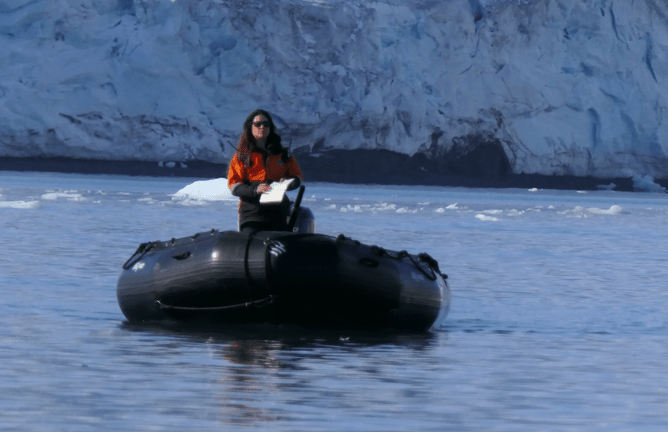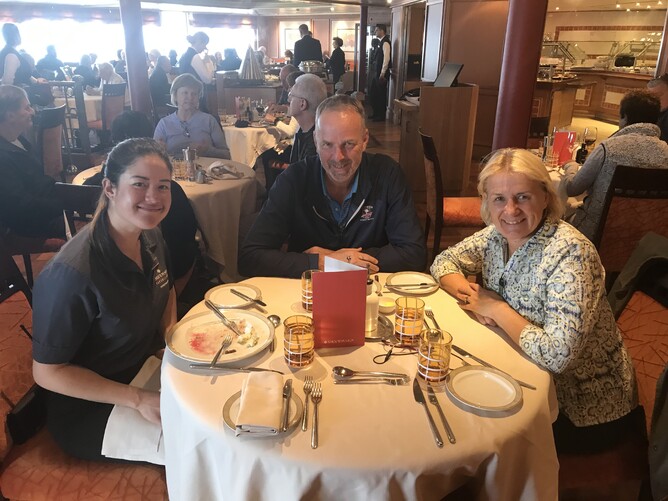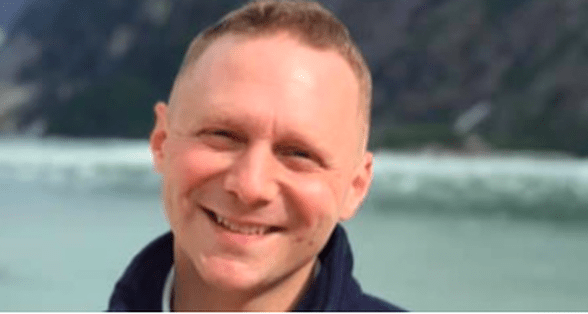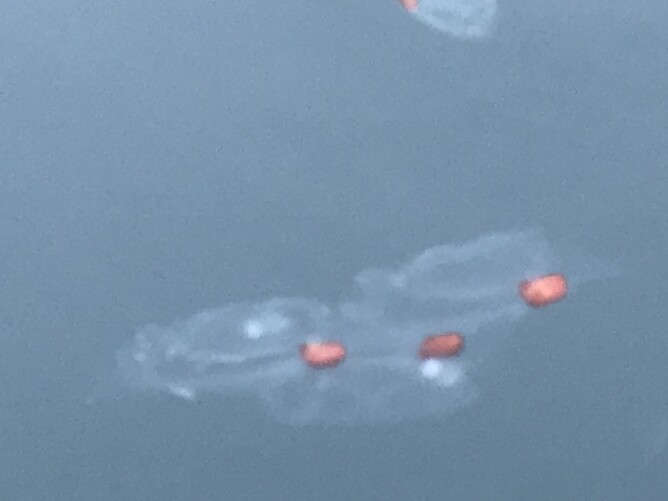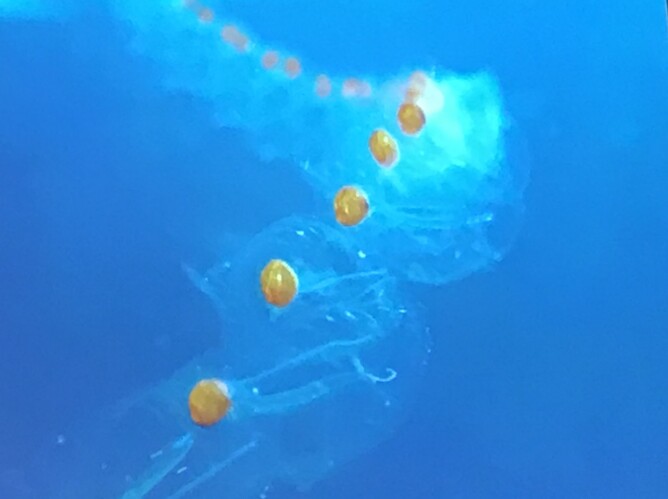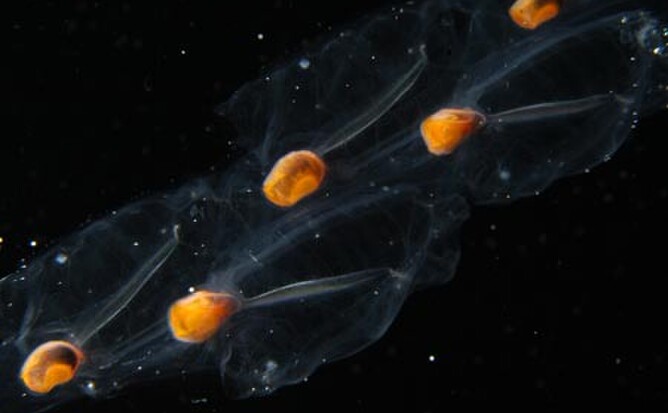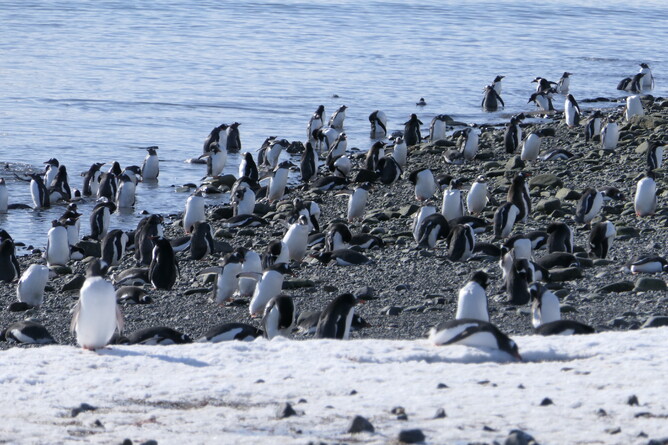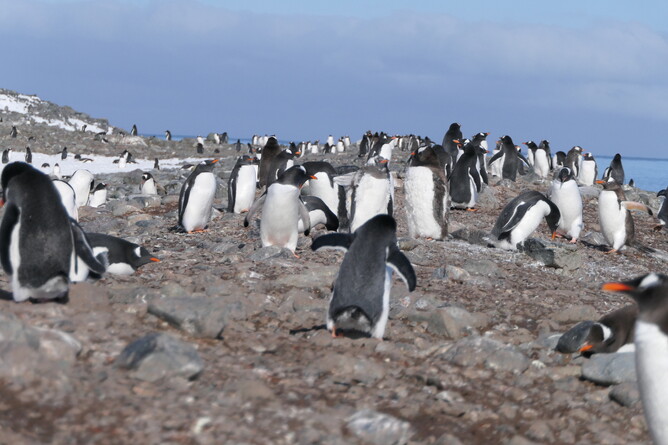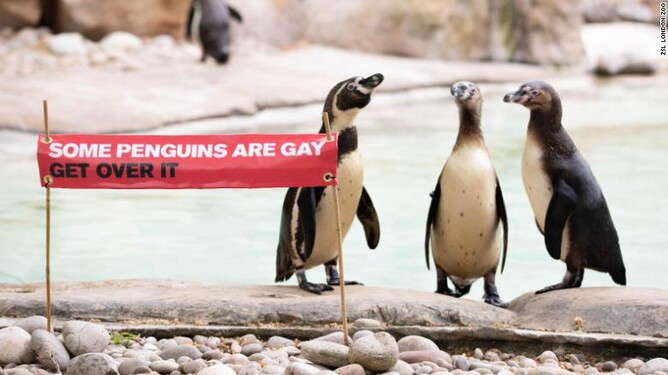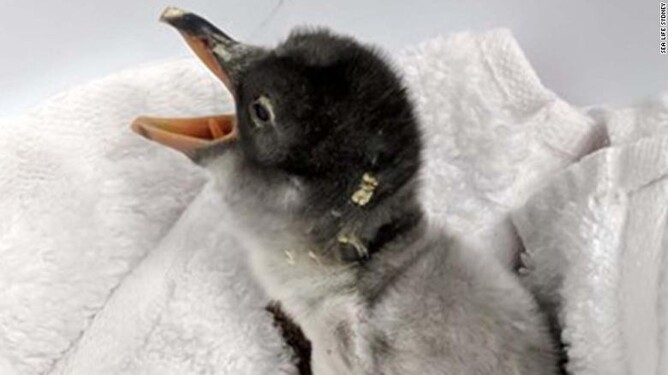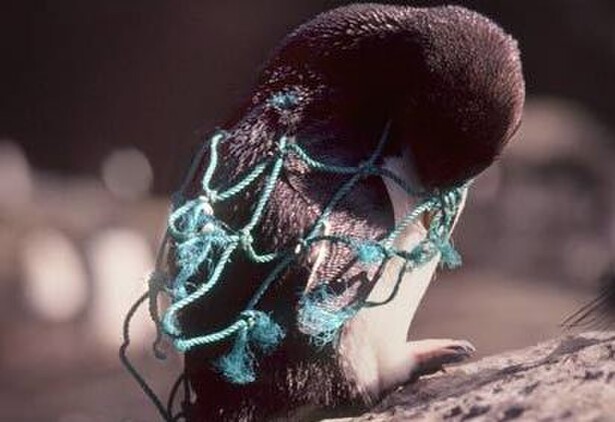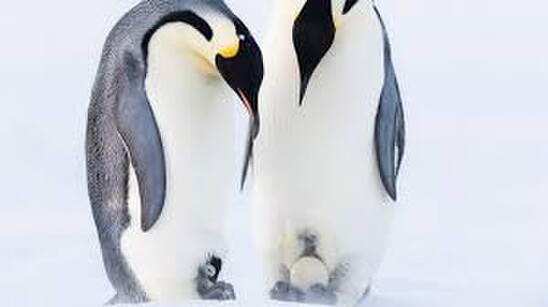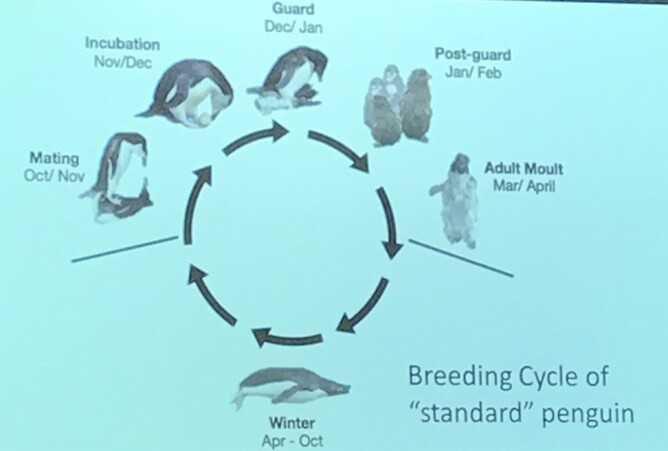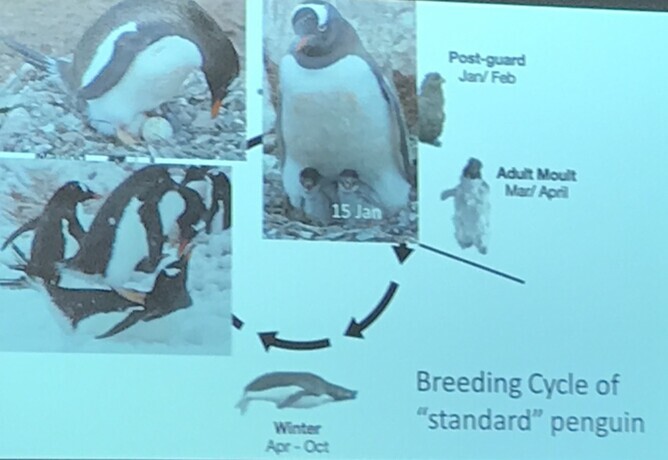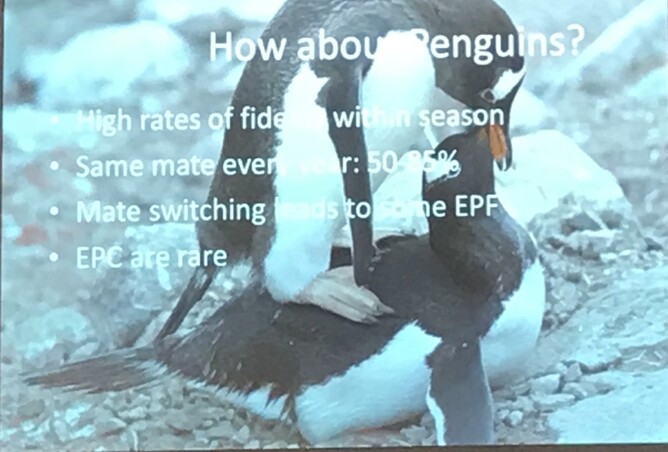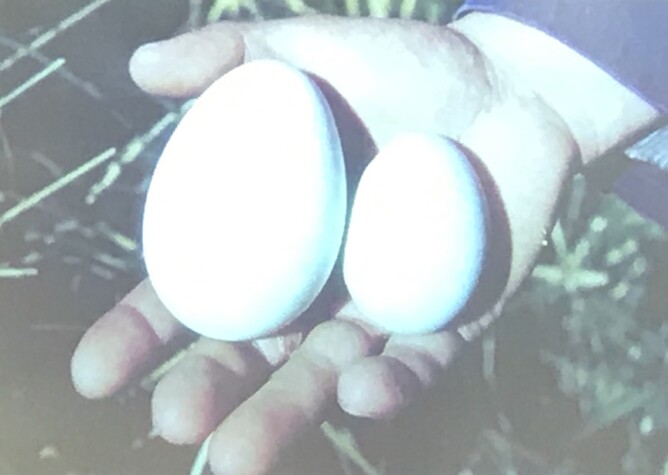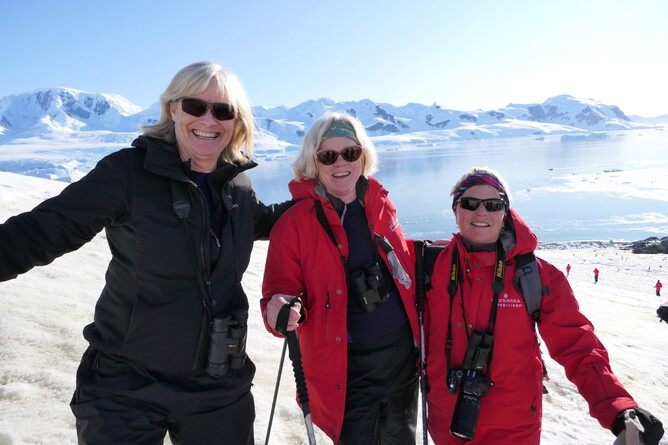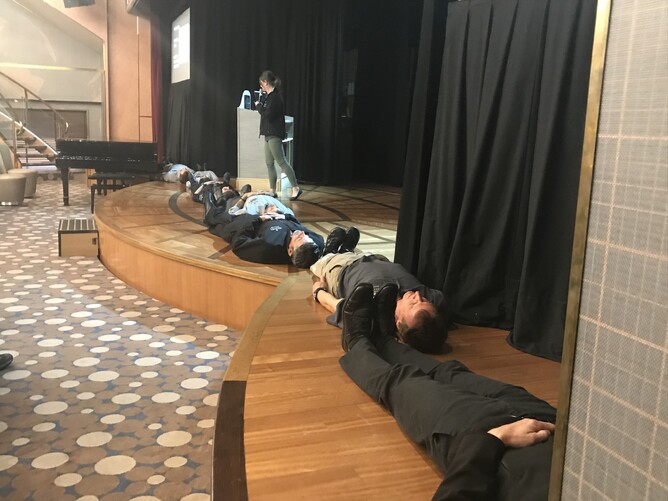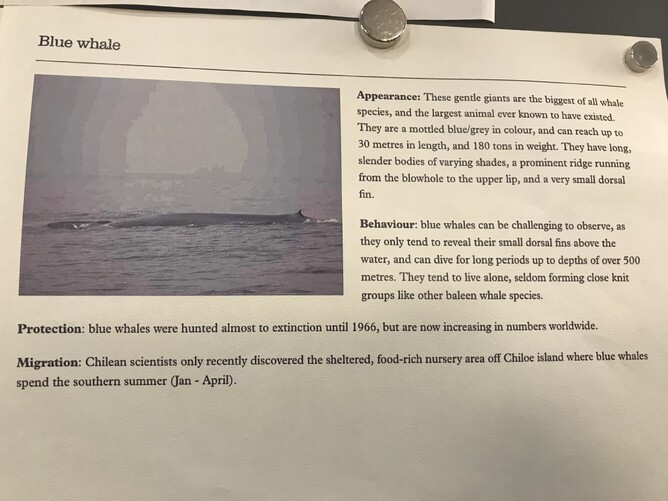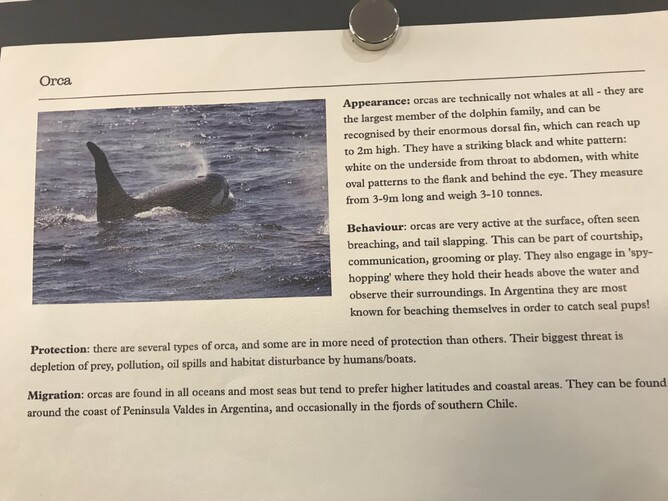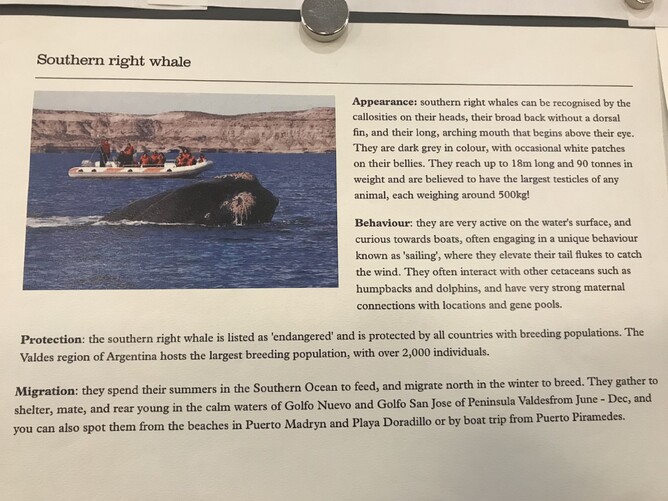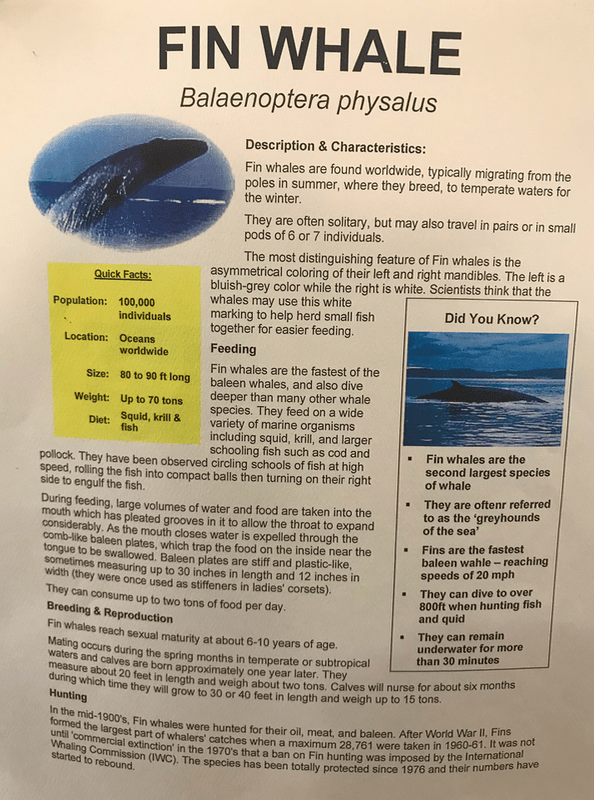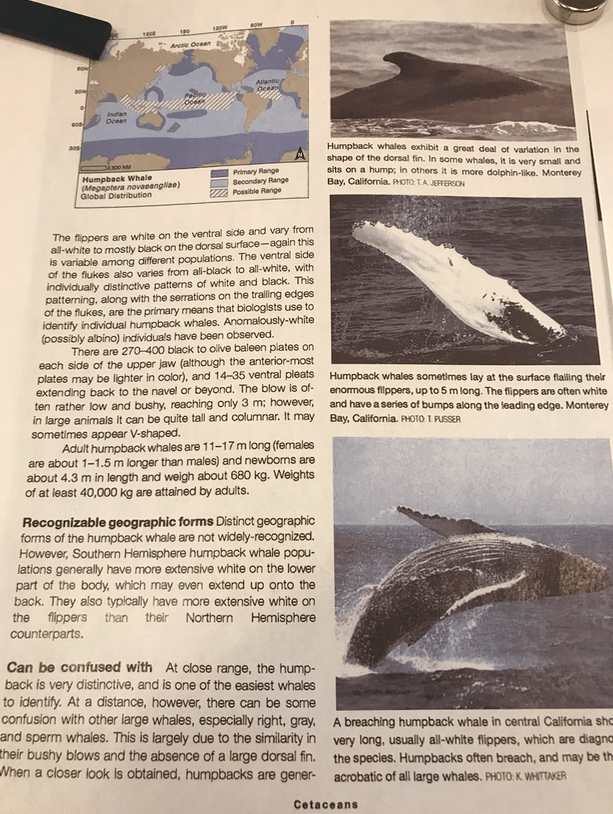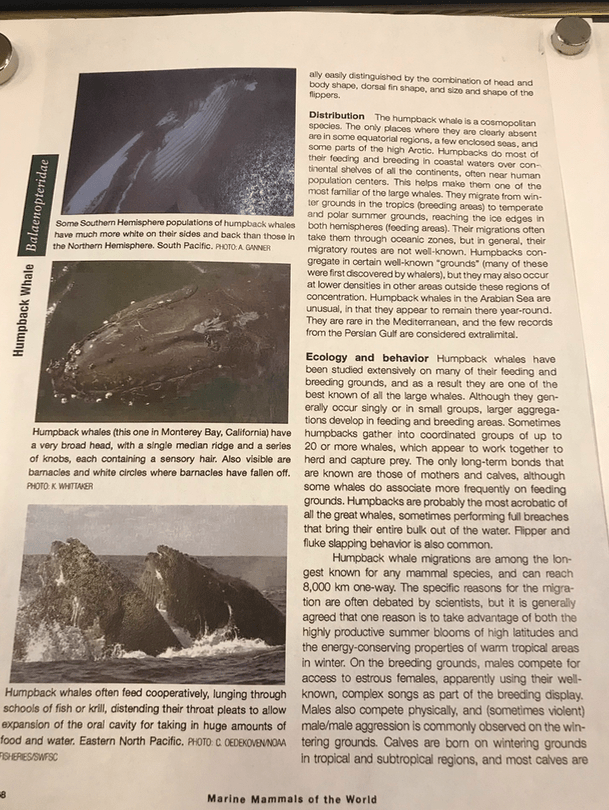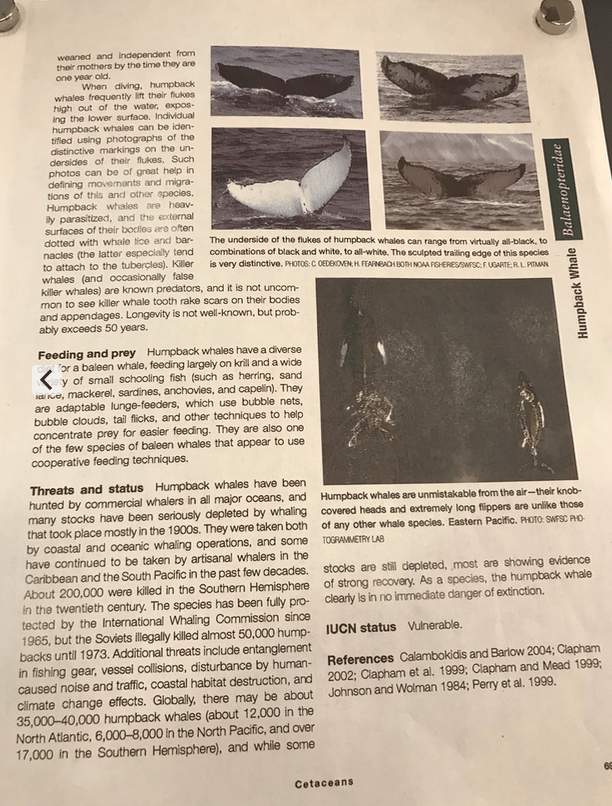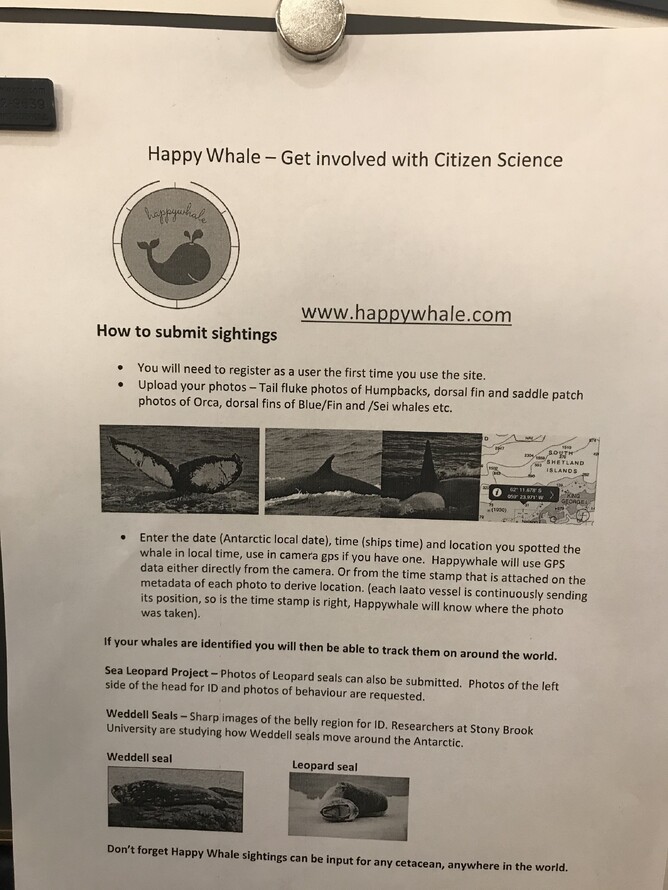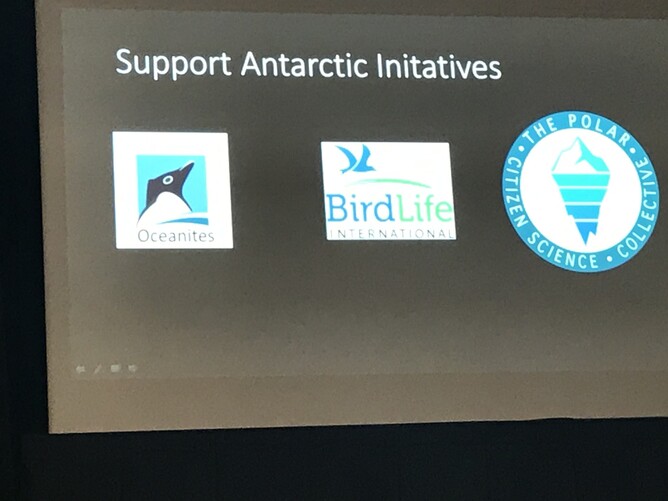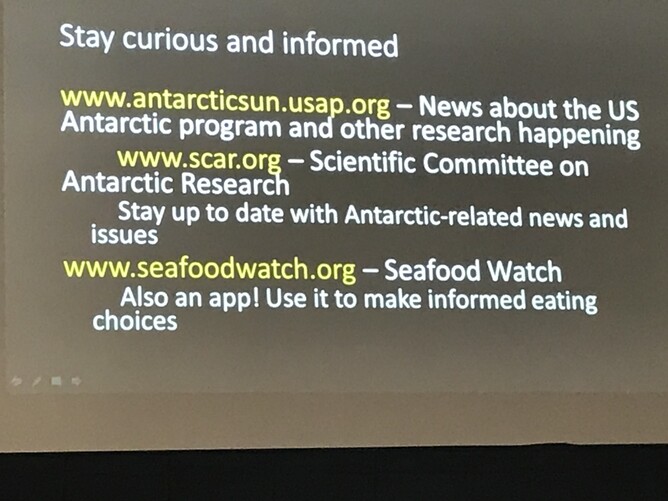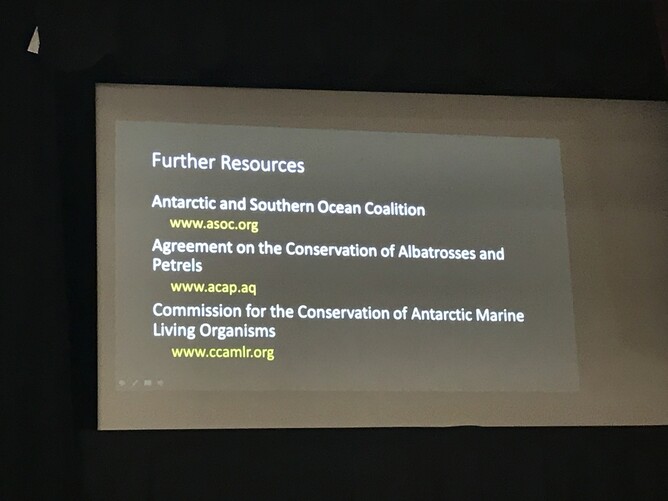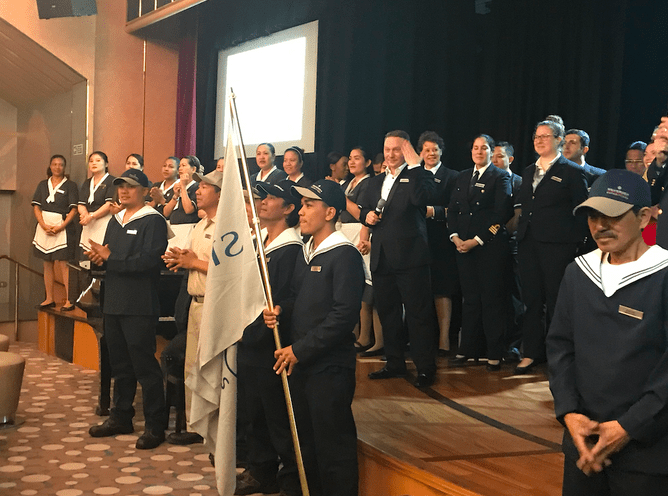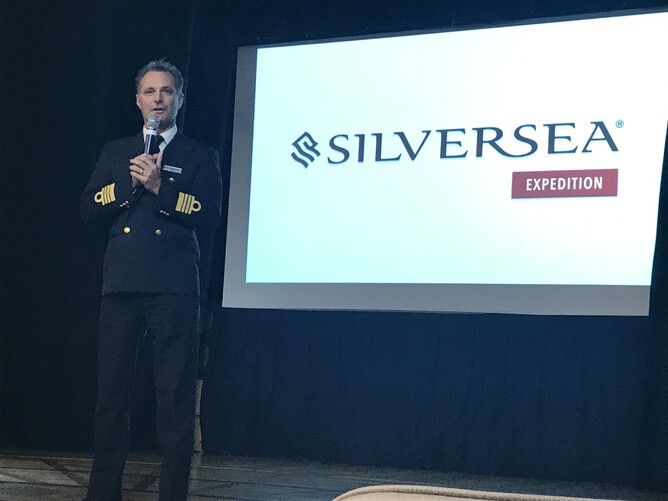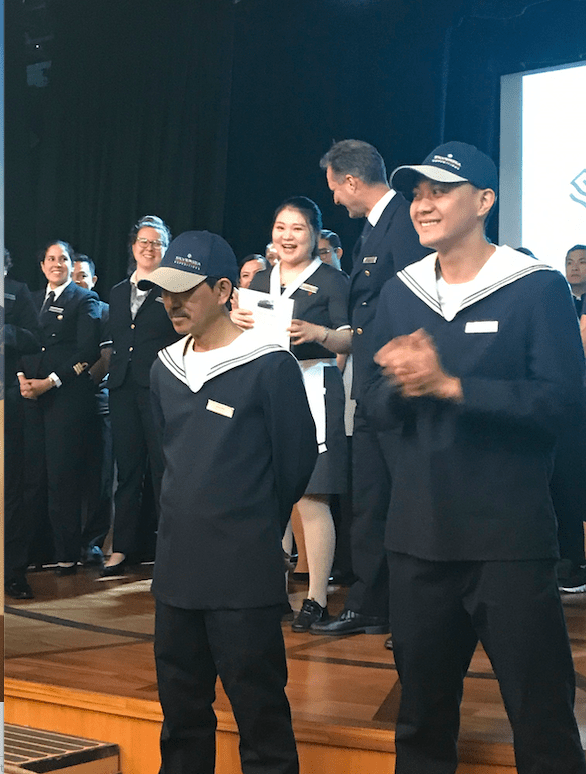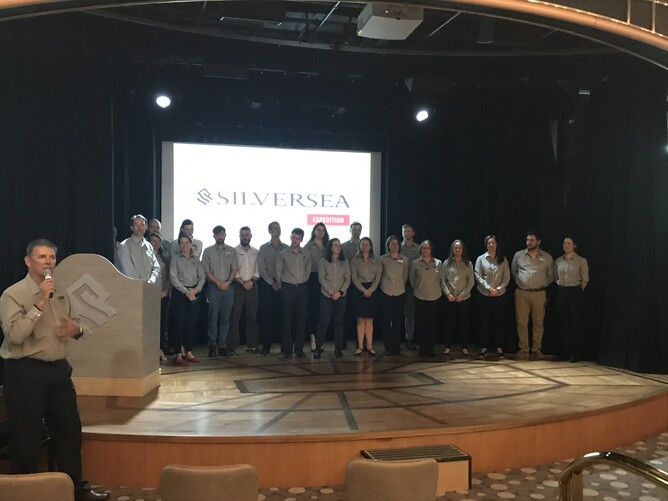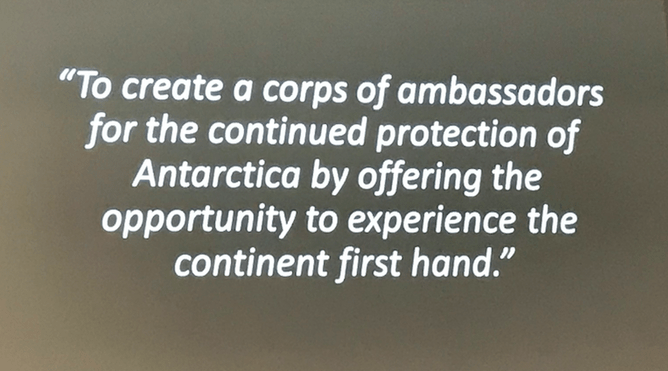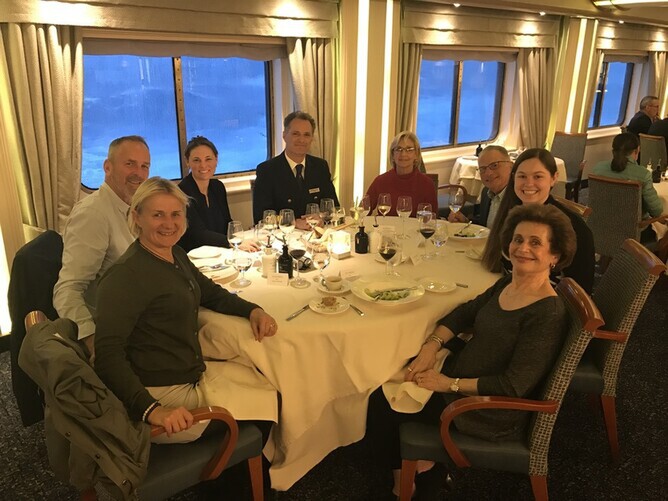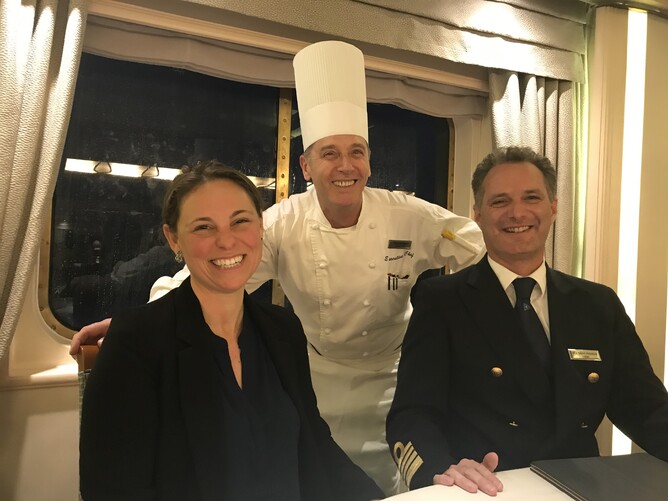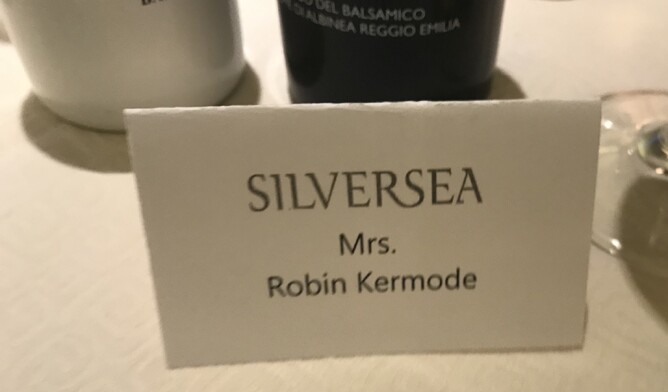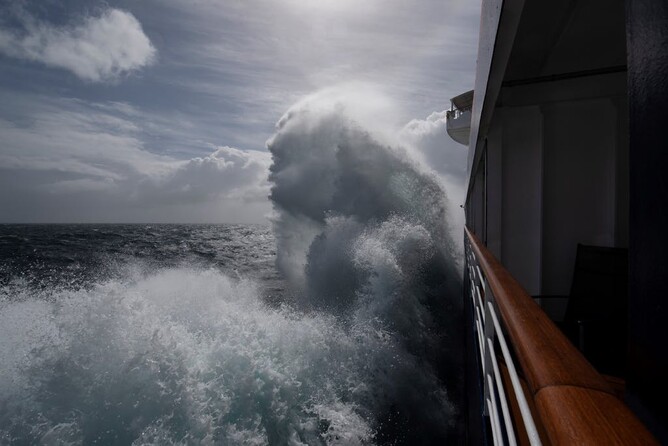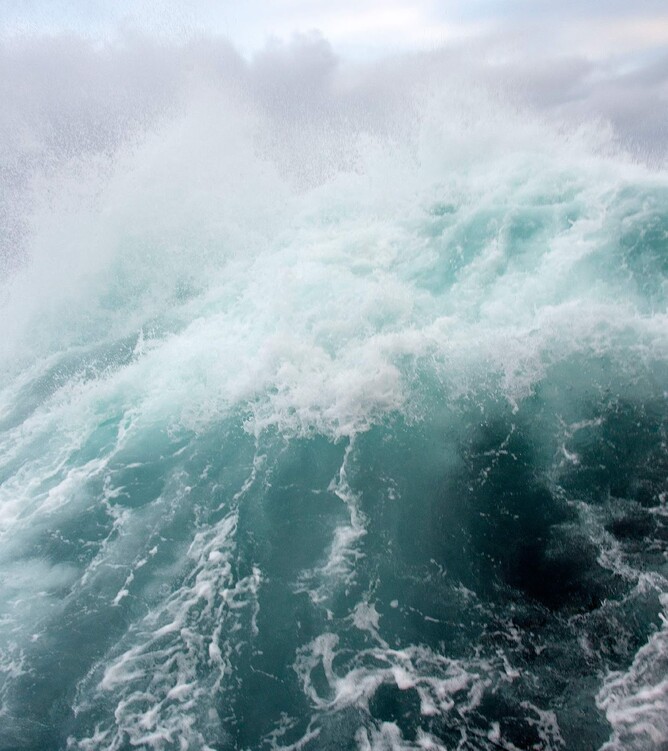We head back to Ushuaia. This is our deck. It is a lot colder outside than it looks, and very warm inside.
We take a walk around level 8, these are some of the zodiacs.
The bridge is open for us to visit. This is the Second Officer who keeps all the physical maps updated.
I take the wheel for a bit.
Then I go to a few talks. Bill chooses to work. The first talk is "Cold Leadership" by Brian Keating. He was a surprise on the programme, because he was a guest. Guests have skills too! Brian presents magically, leaving you feeling like you have been taken on an adventure. I googled him.
"He has hosted a weekly nature column for the CBC, and has been featured on a bi-weekly wildlife segment on the Discovery Channel. He is also the director of the documentary Going Wild in Madagascar, which aired worldwide on Discovery HD-TV, and the author of five children’s books celebrating nature. He was named the “Canadian Hero of the Year” award (2006) from Readers Digest Magazine for his global environmental efforts, and holds an Honorary Doctor of Science degree from Brandon University (2009) and an Honorary Doctor of Laws from the University of Calgary (2011)."
Wow! And I was not disappointed. This is him.
I had heard of the Ernest Shackleton story, but not the detail I learnt in Brian's talk. Shackleton's story is one of outstanding survival, and leadership. Here it is and then I have followed it with some of the lessons I can take related to resilience - relevant for the Covid-19 lockdown we are in around the world at the moment.
Brian titled his talk "Cold Leadership". From Wikipedia: "It was about Sir Ernest Shackleton’s Imperial Trans-Antarctic expedition of 1914–1917, considered to be the last major expedition of the Heroic Age of Antarctic Exploration. The expedition was an attempt to make the first land crossing of the Antarctic continent. After Amundsen's South Pole expedition in 1911, this crossing remained, in Shackleton's words, the “one great main object of Antarctic journeyings”.
The expedition failed to accomplish it's objective, but became recognised instead as an epic feat of endurance. As Brian said, many expeditions failed and I remembered Shackleton's expedition as succeeding. Their ship was named Endurance. The following photos come from these websites - enwikipedia.org, coolantarctica.com, salariya.com, bbc.com, mentalfloss.com, mz.co.nz, smithsonianmag.com, cbsnews.com, https://www.ibiblio.org/ebooks/Shackleton/South/South.htm, and https://www.australiangeograph...
Below is the ad Shackleton placed in the London Times for crew, although there does seem to be dispute as to whether he did actually place the ad - one of the crew members never saw it. I thought it good to put in the blog anyway. As well as getting skill sets needed for the trip he had interviewed crew by asking them to write a poem or sing a song. He knew with so long away they needed to have something else to offer the group.
Endurance in full sail.
First a summary of the journey. Shackleton and his selected team of 25 men sailed from England then Buenos Aires, South Georgia, then to the Antarctic Peninsula. The ship Endurance in the bay at South Georgia before the expedition.
The ship with huskies on board.
Three days after sailing Shackleton discovered a stow away (one of the crew had stowed him on board). From Wikipedia: "Apparently in a fit of genuine rage, Shackleton subjected the stowaway to a most severe and terrifying tirade in front of the entire crew. This had the desired effect and the reactions of the two accomplices were enough to unmask them. Shackleton finished his performance by saying to 18 year old Blackborow, "Do you know that on these expeditions we often get very hungry, and if there is a stowaway available he is the first to be eaten?" To which Blackborow replied, "They’d get a lot more meat off you, sir." Shackleton hid a grin and after chatting with one of the crew members said "Introduce him to the cook first." Blackborow fitted in well with the crew, and ended up being very useful. This is Blackborow and the cat Chippy.
Six weeks after leaving their South Georgia Island south seas base, the Endurance got stuck in the ice. Shackleton realized that his men would have to wait out the coming winter in the ship’s cramped quarters until summer’s thaw. Below is the crew clearing the ice away from the ship.
There was a photographer in the crew, and he took some amazing photographs.
Frank Wild (Shackleton's best friend before the trip, and remained best friends after the trip) and Shackleton.
They all lived on the ship and the ice for close to 11 months, with no hope of rescue and no way to call for help. Shackleton gave his crew jobs and none were lesser he said. He would bunk with his men when there were difficulties.He had his crew take gravitational readings and all sorts of measurements. He kept them busy. He celebrated birthdays and special occasions. He would always eat with his men. He kept them laughing so they would not get dark. Every man had half a biscuit a day. Shackleton fixed it so he had the worst sleeping bag. He always gave them a plan.
And he kept celebrations going to keep the crews' spirits up.
And Shackleton knew that the ship would crush under the pressure of the ice (though he never let on to his men). Eventually it did, and sank - here, watched by the dogs.
When they were ditching things from the ship he made his men bring their journals so they could get thoughts out of their heads. He let go of all personal and gold coins (about 2 pounds in weight each worth). They were to keep photos of their loved ones. As Brian said, Shackleton was a disgusting display of a British gentleman, which gained his mens' respect. Here are the dogs coming off the ship.
And on the ice.
This is Shackleton and Hurley.
The the ice started to break up. They needed to find land. They rowed for a week in three lifeboats (having now visited the region I find even just this part of the story unbelievable), keeping the boats together.
At night they would eat and sleep on ice floes.
They reached Elephant Island and found a flat bit they could camp on.
After arriving at Elephant Island they had a hot cuppa.
Shackleton and Wild, planning I am guessing.
They ate penguins.
This is Hudson with two.
They cooked them up.
They slept in upturned rowing boats.
They were cramped and tried to keep warm.
After five months and some planning Shackleton decided he and a small crew would try to row for 800 miles to get back to the South Georgia whaling station they had left about 15 months previously, to get a ship to save everyone.
Those left behind waving them goodbye.
After 17 days and one hurricane crossing one of the world’s most treacherous seas in a glorified rowing boat . . .
. . . they reached South Georgia - only to discover they were on it's wrong side.
They cross 35km of mountain ranges and glaciers to get to safety.
Three months later they rescue the men left on Elephant Island with a Chilean Admiralty tugboat and a British whaling boat. This photo is Shackleton's men on Elephant Island seeing their rescuers coming - they have a smoke beacon going letting them know where to come to.
I remember two stories from Brian. One was was when Frank Hurley did not have mittens. Shackleton took off his own and gave them to him. Frank would not accept them and Shackleton said he could not go without mittens and said we will both go without them then, and attempted to throw the mittens in to the sea. Frank did end up wearing the mittens and Shackleton got frostbite.
I was kayaking for an hour and a half and sometimes did not have gloves (while I was taking photos). That was enough and any longer I would have got frostbite! Shackleton’s fingers surely were frozen, and I got he put his men first. Here is Frank Hurley, the photographer, whose photos and equipment were only just saved as the Endurance sank.
The second story was after the ship became trapped in pack ice and was destroyed, Shackleton decided that Mrs Chippy, and five of the sled dogs that had been carried on board, would not survive. In a diary entry dated 29 October 1915 he recorded: "This afternoon Sallie's three youngest pups, Sue's Sirius, and Mrs. Chippy, the carpenter's cat, have to be shot. We could not undertake the maintenance of weaklings under the new conditions. Macklin, Crean, and the carpenter seemed to feel the loss of their friends rather badly." This is Crean with puppies he had loved.
Here are the 22 men left behind, joyous at being saved after nine months on Elephant Island.
There was this in the paper when they arrived back in London. It was war time and their homecoming was less than it could have been given the magnitude of their journey.
And here is a movie I found on line about the Shackleton story. Shackleton I discovered was called "The Boss"
Three things I can take from Shackleton’s mission for our Covid-19 lockdown. (With thanks to Bill for starting this off in a NEXT blog he did.)
The first is about realigning your expectations in the face of new circumstances. On realizing that the original mission was doomed, Shackleton knowing they were doomed kept having a plan and kept his men busy everyday in life doing something. He was present to the now. It was almost that he did not want to look ahead. Live in the moment. His new goal was to look after his crew and to plan to return them all safely and alive, and have them concentrate on surviving and living right now. While the odds were against them, he thought if they got dark, they would have no chance. His intention was to return them safely, and to live in the now was the only way he thought they had a chance.
The second is about creating predictability. Shackleton feared the potential effects of idleness, anxiety and disengagement among his men more than he did the ice and cold. He made sure his men had order in their day. That schedule involved to the extent possible the mens’ ordinary duties, games, Teatime, ship related activities (until it sank), food gathering activities, and socialising after dinner, celebrating events, half a biscuit a day etc. By making sure they were not simply sitting around idly he helped them experience an internal sense of structure that helped the days go by smoothly. Through the routines, order and interaction, Shackleton managed the collective fear that threatened to take hold when the trip didn’t go as planned.
Third, Shackleton understood that teams are only as effective as their weakest member. He was famous for his men surviving for three years in harsh conditions.When he identified crew members struggling, he made sure to help them in any way he could. Rather than approaching the situation as “survival of the fittest” he practiced “protection of the weakest”. That approach both inspired confidence that all were cared for equally, and reinforced a loyalty to him as a leader.
Living closely with Bill I will practise Shackleton’s patience and good listening, and not react if Bill does. History remembers Shackleton’s mission not for failing to cross Antarctica, but for the human spirit that shone through. Success in adversity is more than the outcomes that are derived. It is also the “how” of it all – the way we are for ourselves and for others on the journey. I am being Shackleton in my bubble 😊.
Here is sunset at Waiheke in Covid-19 lockdown - it is a lot more hospitable than the Antarctic Peninsula.
After Brian's talk, it was lunch with Nat. She drove the kayak zodiac, and shadowed us when we were kayaking.
We learnt she is a pilot, a photographer and a poet, as well as a wilderness guide! I asked what would be her dream job? She replied immediately - it would be working as a pilot with rescue missions from a Canadian rescue operation called Borek Air http://www.borekair.com/about-us.html. They do polar flights and have a reputation for taking on missions that other airlines will not do - amazing - and brave.
One of the other things I took from lunch was Nat's love for being out in the open in the zodiac. I thought she had drawn the short straw, not kayaking, but she was in her happy place she assured me. Being in Antarctica with the opportunity to have time to yourself is the best gift she said she could give herself. She spent some of her time on the zodiac writing poems.
The photos on her photography site are in a different league to mine, take a look https://www.nataliegillisphotography.ca/ . And I get I am about writing stories too.
This is Nat in the zodiac.
And at lunch.
Then the first afternoon talk was 'Polar Dinosaurs' by Brian Bailey / Julia. He said "I have spent my entire career in the entertainment industry from Broadway and TV to cruise lines and arts education. This has allowed me to travel the world and gain knowledge and understanding from a variety of countries, cultures, and natural wonders. I'm a Member of Actor's Equity, IATSE, and an Eagle Scout." He has so much knowledge and I love the way he presents. He is a real professional. This photo taken from LinkedIn.
He talked about salps, which I had never heard of even though I had photographed them when we were kayaking, so realised that was what he was talking about. They were everywhere.
I learnt they are 95 percent water, closely related to humans, they tunicate (have a series of layers as a bulb with a spinal chord), they move by jet propulsion, there are 70 species of salps, they thrive in the southern ocean, and they are food for penguins, seals, sea lions and whales.
More about them from the internet: "The chain of salps, called the “aggregate” stage, after it leaves the parent. The photo shows how they are attached, one to the other. The rows of orange-brown spots are the stomach of the salps."
Next up it was Martin on penguins.
Penguins are closer to humans then you might think. Both raise families and offspring get really attached with their parents. Human children may never want to let go of Mum and Dad and play with other kids early on, and penguin babies don’t want to leave their mother’s or father’s body and protection. You see the adult not feeding the chick or the chick chasing the adult for food.
Both penguins and humans take turns carrying their young. Penguins take turns carrying the egg and baby so the other parent can provide food, and human parents take turns holding and feeding their child. We also both walk on two legs.
For me maybe the biggest similarity between us is that we both like to play and have fun. Baby penguins play with the other fellow newborns in the same way humans play with other kids.
Then some differences - penguins live 15-20 years, humans live on average 71-74 years. Some of this may be due to penguins having to hunt for their food - not buy it. And they have predators, and most important, the climate difference. Penguins live in the toughest climate on Earth, we live in a warm home and if we don’t like where we live, we can move.
Penguins use the syllables available to them to speak in the most economical fashion they can. A paper published in the Biology Letters journal suggested they reserve the shorter ones for the most common calls.
Martin says in a colony you can see good intentions, and can find exceptions.
Team cooperation is necessary. Extra-pair copulation (EPC) does happen in penguin colonies, some more than others. (Another similarity with humans, Ed.) From Wikipedia: "Monogamy occurs when an individual has only one sexual partner at any one time, forming a long term bond and combining efforts to raise offspring together; extra-pair copulation occurs when one of these individuals mates outside of this pairing. Across the animal kingdom, extra-pair copulation is common in monogamous species, and only a very few pair-bonded species are thought to be exclusively sexually monogamous. EPC in the animal kingdom has mostly been studied in birds and mammals. A possible benefit of EPC is that males maximise their reproductive success by copulating with as many females as possible outside of a pair bond relationship because their parental investment is lower, meaning they can copulate and leave the female with minimum risk to themselves. Females, on the other hand, have to invest a lot more in their offspring; extra-pair copulations produce a greater cost because they put the resources that their mate can offer at risk by copulating outside the relationship. Despite this, females do seek out extra pair copulations, and, because of the risk, there is more debate about the evolutionary benefits for females." I found this YouTube video about the gentoo penguin.
They've also been observed some times having same-sex partnerships. In Sydney's Sea Life Aquarium a same-sex penguin couple just became parents. Sphen and Magic - or Sphengic, as they are collectively known - proved themselves natural parents when they incubated a dummy egg given to them by staff at Sydney's Sea Life Aquarium, where they live. They were then entrusted with a real egg from another couple that laid two during this year's breeding season. Because gentoo penguins usually have only enough resources to raise one egg successfully, the "backup" chick often dies.
Sphen and Magic began developing a strong bond and became inseparable before a breeding season, according to staff at the aquarium. Visitors would often spot the pair waddling around and going for swims together, which was why they were deemed to be suitable prospective parents.The sub-Antarctic penguin chick was born Friday, October 19.
Some questions Martin has been asked about penguins:
Do penguins produce milk? The Emperor penguin does produce a type of milk for a few days.
Are there penguins at the South Pole? No.
Where do most penguins live? Most penguins live in sub-Antartica.
Do penguins get caught in nets? Humble penguins have been found in an Alaska fishing net.
Do all penguins build a nest? King penguins are the only penguins who do not lay a nest. They transfer eggs male to females.
What is the go with pebble nests? Pebbles are needed for nests to protect eggs and keep eggs dry from melting snow. The nest is a status system too. They are equally choosy about their mate.
How long does it take to raise a chick? King penguins take more than a year to raise a chick, they usually raise 2 chicks every 3 years. Some species (such as the blue penguin) can raise more than one chick in a season.
Note EPC is rare with Adelie penguins.
Penguin species have peculiarities:
Brood reduction often occurs as infanticide, the killing nestlings by members of the same species. Infanticide can be done by siblings, which is referred to as siblicide, or by the parents, which is called filial infanticide. In virtually all species, brood reduction only occurs via siblicide. It happens more in some species of penguins than others. I will have to do more homework on this later.
Some penguin species impregnate the female as their chicks leave the nest.
Eggs in crested penguins - starts off with two eggs, gives one away to the skua's or lets go of one (maybe the best looking/stronger one).
60,000 tourists go to the Antarctic every year to visit penguins. We don't know what impact penguin visiting has on penguins really. Best to keep a 5m distance unless they come to you.
Then Kirsty talked about whales - first, the incredible size of a blue whale. She got her expedition leaders to lie down to show us - they are big! The equivalent of six elephants. They measure 5 meters across the tail.
She talked about humpback whales. We never saw this. Imagine if you were in the boat. We saw heads, backs and tails, and just that was pretty spectacular. This memory would be the wow of a life time. We also didn't go to Wilhelmina Bay.
Facts about whales from the notice board.
Kirsty also talked about an organisation you could support for saving the whales . . .
. . . and support Antarctic initiatives, . . .
. . . and to . . .
. . . and . . .
As it was our last night on the water, Brian / Julia re-introduced many of the staff and the Captain, in his usual entertaining and professional manner.
Then it was Captain Eric's turn to farewell us . . .
. . . and thank all the crew.
Song, our cleaner, won a safety award voted by the crew.
A thank you from Schalk to his guides. They were all so passionate, professional, articulate and talented was all I could keep thinking. I felt privileged to be in their company, and especially thought of the lovely dinners we had had with some of them.
There was an auction of a map with artwork on it, drawn by a crew member - they are so talented. Proceeds go to the crew fund - it sold for more than $1,000.
The final message.
Then it was time to go for dinner, with the Captain and his wife Kelly. We had thought everyone would be there. It was wonderful to be in a selected group of eight. Here we are - Marilyn, grandmother of Dana, Dana from Detroit (a 19 year old who has a very cool blog), Harold and his wife Gail from Daytona Beach, Captain Eric Saint-Plancat and his angel wife Kelly, Bill and me.
I think we were invited because we invited them! I did not ask how the others got to be invited. We all felt privileged just to be there. The chef called in on us.
It was a very special dinner. I loved all of the conversations. Marilyn's husband had passed away. He had been an ophthalmologist. I loved that Dana and her grandmother were travelling together. Dana was the youngest at dinner at 19, and to me she was wise and a superstar. She had been a top gymnast, now she is a top blogger, top dietician and top traveller.
We heard about the Captain’s years yachting around the world with his family (he is from France but now “lives” in New Zealand, though they are all moving to Vancouver Island where Kelly comes from). He sailed around the world for 10 years with his young family. He has two children. They are now 16 (a boy) and 19 (a girl). We heard about his 19-year-old daughter’s boyfriend who is a New Zealander (maybe hard for her to leave?), and how he and Kelly met working together on a private yacht.
We heard about Harold. He is retired and was an ophthalmologist and a POW in Vietnam.
It was a very fun night. I photographed my name tag.
While we were enjoying the dinner and each other's company, the ship rocked more and more and plates starting sliding off the table. Eric said he had chosen this side of the restaurant because the other side was getting hit harder by the waves! He left the table to make an announcement to everyone. I cannot remember exactly what he said, but his voice was calm and soothing and something like "We are in the Drake Passage, we knew we would get the turbulence. There is nothing to worry about. Our forecast for today was 3-4 metre swells, tomorrow is 6+ metres so better to be going fast today. The ship can withstand this. Hold on and enjoy your last night on the ship."
A lady I bumped into (probably literally, Ed.) after dinner said she was so pleased when the Captain made that announcement. She was getting worried and it gave her peace of mind. It was such a wonderful day and dinner, and the Drake Passage crossing, for a while rougher than the trip to Antarctica, all added to the flavour of where we were - and a story we could tell later.
